Solo Travel in Milan: Ultimate Guide to Top 10 Attractions

Explore Milan Like a Local: Top 10 Must-Visit Attractions Perfect for Solo Travelers
Milan—the stylish heart of Italy—is a city that perfectly blends rich history, artistic masterpieces, and modern innovation. As a solo traveler, Milan opens its arms with vibrant neighborhoods, iconic landmarks, and hidden gems waiting to be discovered. Whether you’re marveling at the majestic Duomo, navigating the artistic charm of Brera, or soaking in the lively Navigli canals, there’s something here for every adventurer exploring on their own. In this guide, we’ll showcase the top 10 attractions in Milan that promise to make your solo journey unforgettable.
1. Duomo di Milano Cathedral
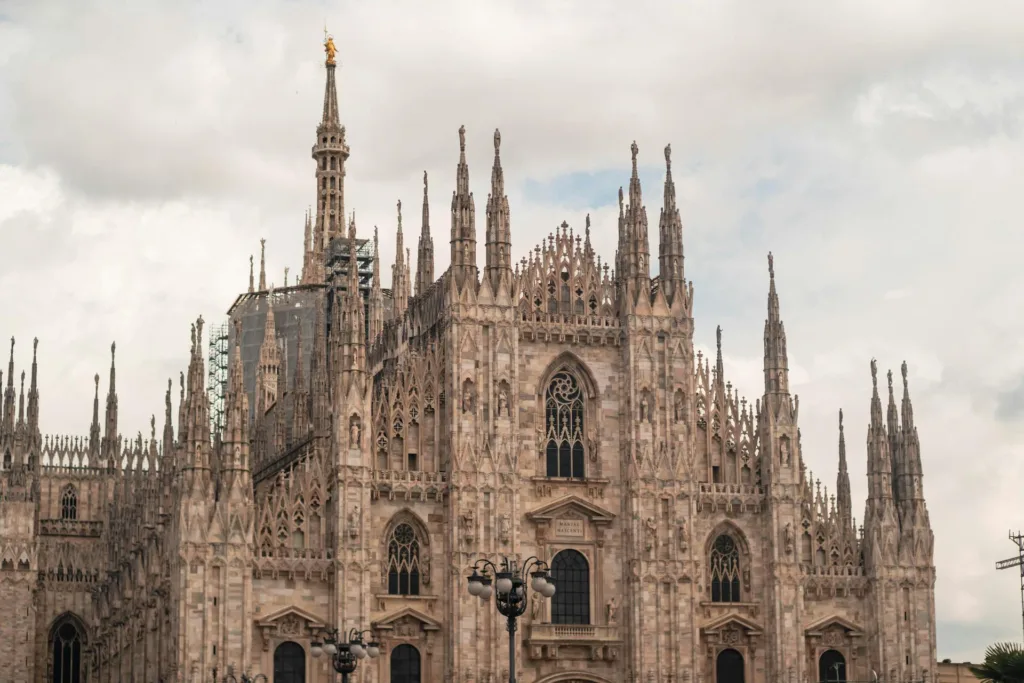
Photo by Alejandro Aznar
The Duomo di Milano isn’t just a cathedral—it’s Milan’s most iconic symbol and a masterpiece of Gothic architecture. Whether you’re a history lover, an art enthusiast, or someone who simply wants to marvel at something extraordinary, the Duomo offers an experience that feels utterly personal, especially as a solo traveler.
What Makes the Duomo Special
- Architectural Wonder: Taking over six centuries to complete, the Duomo is a marvel of human craftsmanship with its 135 spires and over 3,000 intricately carved statues.
- Breathtaking Rooftop Terraces: Walking among the spires and gazing out over Milan’s rooftops is a surreal experience you simply won’t forget.
- Historical and Spiritual Significance: This isn’t just a church—it’s the heart of Milan. For centuries, it’s been a gathering place for locals and an enduring symbol of the city’s faith and perseverance.
How to Experience the Duomo Solo
- Start Early: Arrive in the morning to skip the crowds and enjoy a peaceful atmosphere. For solo travelers, early mornings also mean fewer interruptions and plenty of time to take in the details.
- Choose Your Ticket:
- Basic Entry: Grants access to the cathedral’s stunning interior.
- Rooftop Access: Offers the opportunity to wander through the terraces, with options for stairs or an elevator.
- Combo Tickets: Includes the Duomo interior, rooftop, archaeological area, and museum, making it a great value for enthusiasts.
- Visit the Rooftop First: Solo travelers will love the freedom to move at their own pace, weaving among the spires while enjoying panoramic views of Milan.
- Explore the Interior: Step inside to admire the majestic stained glass windows, towering columns, and the crypt where Saint Charles Borromeo rests.
Practical Information to Plan Your Visit
Getting the logistics right will make your visit to the Duomo smooth and enjoyable. Here’s what you need to know:
- Where Is It?
The Duomo is located in Piazza del Duomo, Milan’s central square. From this plaza, you’ll also see other landmarks like the Galleria Vittorio Emanuele II. - How to Get There:
- By Metro: Take Line 1 (Red line) or Line 3 (Yellow line) to the Duomo stop—you’ll step right into the piazza.
- By Tram: Tram lines 3, 12, 15, 16, 19, 24, and 27 all stop at or near Piazza del Duomo.
- On Foot: If you’re staying in the Brera or Navigli districts, a leisurely walk (approximately 15 to 25 minutes) will get you there.
- Entry Fees:
- Cathedral Only: Approx. €5 ($5.50 USD).
- Rooftop Access (Stairs): Approx. €10 ($11 USD).
- Rooftop Access (Elevator): Approx. €15 ($16.50 USD).
- Combo Pass (Cathedral, Rooftop, Archaeological Area, Museum): Approx. €20 ($22 USD).
- Opening Hours:
- Cathedral Hours: Typically open daily from 9:00 AM to 7:00 PM(last admission 6:10 PM).
- Rooftop Hours: Open daily from 9:00 AM to 7:00 PM, with the last entry at 6:10 PM.
- Closed Days: Rarely closed, but special events, holidays, or maintenance may limit access.
- Accessibility:
- The interior is wheelchair accessible, and there’s an elevator option for rooftop access. However, once on the terraces, navigating the pathways may involve stairs and uneven surfaces.
Highlights You Can’t Miss
- The Rooftop: Walking among the Duomo’s marble spires feels like stepping into another world. The views of Milan’s skyline are fantastic, and the intricate carvings up close are spectacular. Look for the Madonnina, the golden statue that crowns the building.
- Stained Glass Windows: These windows illuminate the interior with colorful scenes depicting biblical stories. Solo travelers can take their time appreciating the artistry.
- Saint Bartholomew Sculpture: This masterpiece, showing the saint flayed with incredible anatomical detail, is a must-see inside the Duomo.
- Underground Archaeological Site: Beneath the cathedral lies an ancient Christian basilica and ruins dating back to Roman times—perfect for history buffs.
- The Facade: Don’t forget to absorb the exterior before stepping inside. The intricate carvings and stunning details on the white marble are mesmerizing.
Nearby Attractions for Solo Travelers
After visiting the Duomo, explore these spots within a few minutes’ walk:
- Piazza dei Mercanti: A quieter square filled with medieval architecture and a glimpse of historic Milan.
- Galleria Vittorio Emanuele II: Known as Milan’s “Living Room,” this stunning shopping arcade is perfect for window shopping or a quick espresso.
- Museo del Novecento: Next door to the Duomo, this museum houses an impressive collection of 20th-century Italian art.
Insider Tips for Solo Travelers
- Dress Modestly: The Duomo has a strict dress code (no shorts, bare shoulders, or mini skirts). Throw a scarf or shawl in your bag to cover up if needed.
- Travel Light: Security checks are in place, so avoid bringing large bags or backpacks.
- Skip the Lines: Booking tickets online or opting for a fast-track passcan save you hours during peak season.
- Best Photo Times: Morning light highlights the facade, while late afternoon creates stunning rooftop views.
Did You Know?
- The Duomo is the largest church in Italy and one of the largest in the world—it can hold up to 40,000 people!
- It was built using Candoglia marble sourced from a nearby quarry, transported via canals directly to the cathedral site.
- Locals lovingly refer to its golden Madonnina spire as the guardian of the city.
The Duomo di Milano isn’t just a must-see—it’s an experience that stays with you. For solo travelers, it offers more than beauty and history; it provides a chance to connect with Milan, its culture, and yourself.
2. The Last Supper: Leonardo da Vinci’s Masterpiece

Image by Kim Hunter
Leonardo da Vinci’s The Last Supper isn’t just a painting—it’s one of the most celebrated masterpieces in the history of art. Painted on the wall of a former dining hall in the Santa Maria delle Grazie convent, this iconic mural continues to inspire awe among visitors from around the world. For solo travelers, it’s a chance to truly immerse yourself in history, creativity, and a story that has captivated people for centuries.
Why The Last Supper Is a Must-See
- Historical Significance: Created between 1495 and 1498, The Last Supper is one of Leonardo da Vinci’s most recognized works, depicting the emotional moment when Christ reveals his betrayal.
- Artistic Innovation: Leonardo used an experimental technique blending tempera and oil on plaster instead of traditional fresco. Although the mural began deteriorating soon after completion, its power and beauty remain unmatched.
- Emotional Impact: The painting’s remarkable detail and storytelling make it an incredibly moving experience. For solo travelers, this is an opportunity to reflect on the brilliance of one of history’s greatest minds.
How to Experience The Last Supper
1. Book Tickets in Advance (Seriously!)
Tickets for The Last Supper are notoriously hard to come by and must be booked weeks—sometimes months—in advance. Only 30 people are allowed inside at a time, and visits are limited to 15 minutes.
- Where to Book: Official website or authorized tour operators. Combo tickets with guided city tours often include guaranteed access.
- Ticket Prices: Starting at €15 ($16.50 USD), with additional options for guided experiences.
2. Timing Your Visit
- Arrive 20-30 minutes before your entry time for security checks and luggage storage.
- Mornings tend to be quieter and offer more peaceful moments for solo travelers.
3. Pair It with Nearby Experiences
- Visit the stunning Santa Maria delle Grazie church, a UNESCO World Heritage site that houses The Last Supper.
- Take a walk to Corso Magenta, a charming street filled with boutiques, cafés, and local shops.
Practical Details
- Where Is It Located?
The Last Supper is housed at the Convent of Santa Maria delle Grazie, located at Piazza di Santa Maria delle Grazie, 2, 20123 Milan. - How to Get There:
- By Metro: Take Line 1 (Red) or Line 2 (Green) to Cadorna Station. From there, it’s a 10–15 minute walk.
- By Tram: Tram line 16 stops nearby.
- On Foot: If you’re staying in central Milan by the Duomo, it’s about a 25-minute walk.
- Entry Fees:
- Starting at €15 ($16.50 USD) for basic admission. Guided tours range from €35–€60 ($39–$66 USD).
- Opening Hours:
- Typically open Tuesday to Sunday from 8:15 AM to 7:00 PM (last entry at 6:45 PM).
- Closed on Mondays.
- Tour Options: Guided or audio tours provide extra context about The Last Supper, its restoration, and its cultural significance. Perfect for truly understanding this masterpiece.
Highlights of The Last Supper
- The Moment Captured: Leonardo’s mural brilliantly captures the tense emotional moment of Jesus announcing his betrayal. Pay attention to the details: the gestures of the apostles, the dramatic composition, and how Leonardo uses expressive faces to tell the story.
- Restoration Legacy: The mural has undergone numerous restorations over the centuries due to its delicate condition. The modern-day Last Supper is the result of extensive efforts to preserve it while staying true to Leonardo’s vision.
- The Dining Hall: The room itself, with its centuries-old walls and echoes of the past, adds a sense of reverence to the experience.
Tips for Solo Travelers Visiting The Last Supper
- Book Early: Solo travelers have more flexibility with dates, but tickets still sell out fast, so secure yours as soon as your travel plans are set.
- Arrive Prepared: There’s a security screening, and bags must be stored before entry. Travel light to save time.
- Use App or Guide: Download an art guide app, or join a guided tour to fully appreciate Leonardo’s techniques, symbolism, and history.
- Savor the Moment: 15 minutes may seem short, but it’s enough to soak in the painting’s details and atmosphere. Use this time for reflection.
- Combine with Nearby Attractions: Santa Maria delle Grazie itself is a work of art, and its cloisters are a peaceful gem often overlooked by visitors.
Did You Know?
- Leonardo da Vinci experimented with a new painting technique for The Last Supper, which made it prone to deterioration. The work began to flake and fade just 20 years after it was completed!
- During World War II, the convent was bombed, and the mural nearly didn’t survive. Protective sandbags are what saved it from total destruction.
- The layout of the room, with the mural at one end and another fresco of the Crucifixion by Giovanni Donato da Montorfano at the opposite wall, creates a stunning visual balance.
Why Solo Travelers Love This Experience
- Thoughtful Reflection: Witnessing The Last Supper is a deeply personal experience that solo travelers can fully savor without distractions.
- Freedom to Absorb Details: Explore at your own pace, soaking in details that others might glance over.
- A Unique Milanese Memory: Seeing this masterpiece is a once-in-a-lifetime opportunity, and as a solo traveler, it becomes a moment you get to cherish entirely for yourself.
Pair Your Visit
- Stop for a cappuccino or lunch at a nearby café on Corso Magenta, just a short stroll away. It’s the perfect street for a relaxed solo meal or pastry break.
- Walk to Leonardo’s Vineyard, located just steps from Santa Maria delle Grazie, for insights into Leonardo’s life in Milan. Tickets include entry into the picturesque Rennaissance home of the Atellani family.
Visiting The Last Supper isn’t just about seeing a painting—it’s about experiencing the genius of Leonardo da Vinci and connecting with one of the most pivotal works of art in history. For solo travelers, this intimate, awe-inspiring masterpiece offers a serene yet profound moment of reflection.
3. Galleria Vittorio Emanuele II: Milan’s Living Room
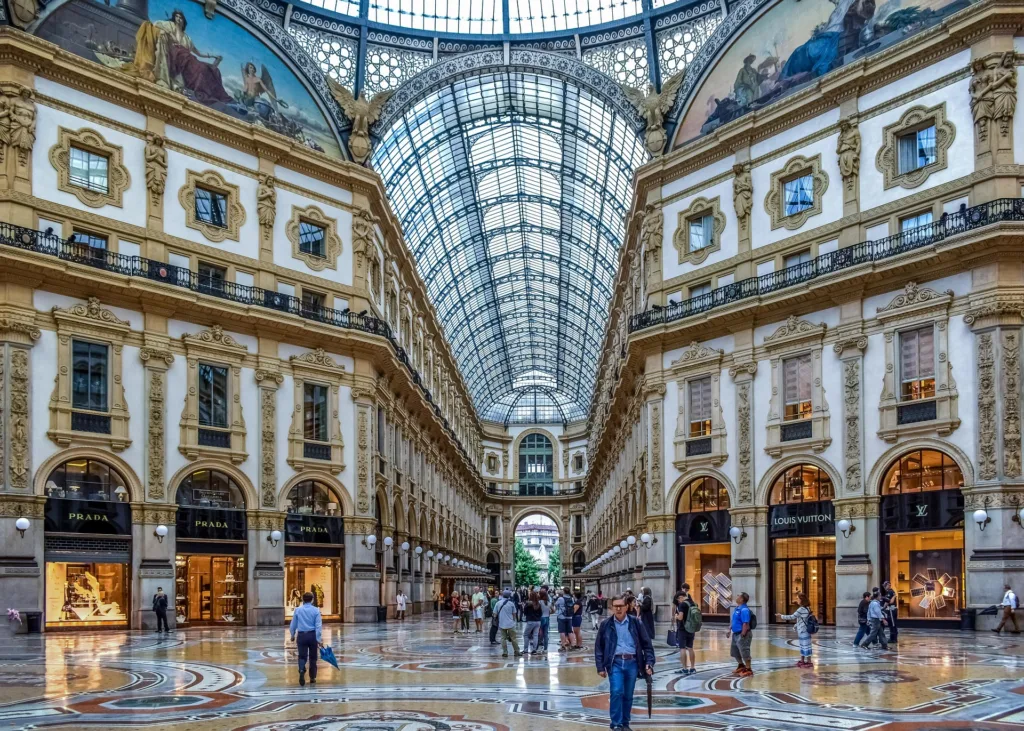
Often referred to as Milan’s “Living Room,” the Galleria Vittorio Emanuele II is not just a shopping arcade—it’s a masterpiece of architecture and an experience in its own right. Its grand glass domes, ornate mosaics, and luxury boutiques make it a must-visit for anyone exploring Milan. For solo travelers, it’s the perfect space to soak up history, elegance, and moments of quiet indulgence.
Why the Galleria Is a Must-See
- Architectural Marvel: Completed in 1877, this 19th-century gem seamlessly blends neoclassical and Renaissance influences. The soaring glass dome and intricate tile floor designs feel like walking through a piece of art.
- Luxury Meets History: As one of the world’s oldest shopping arcades, the Galleria brings together Milan’s love for fashion, tradition, and beauty all in one place.
- Iconic Atmosphere: The Galleria captures Milan’s essence—chic, vibrant, and timeless. For solo travelers, its atmosphere is captivating and filled with opportunities to linger, observe, or indulge.
How to Experience the Galleria
- Marvel at the Architecture: Take your time walking through the arcade and admiring its intricate mosaics, grand arches, and sunlit dome. Pro tip: Look up to fully appreciate the steel-and-glass roof and artistic details.
- Spin for Good Luck: Head to the mosaic of the bull on the floor, located under the central dome. Tradition says that spinning three times on the bull’s heel brings good fortune—just follow the crowd and join in!
- Indulge in a Treat: Stop at one of Milan’s finest cafes, Camparino in Galleria, for an espresso or a Negroni. Relax and take in the elegant surroundings while doing one of Milan’s favorite activities—people-watching.
- Window Shop Without Pressure: Whether you’re browsing luxury brands like Prada, Gucci, or Louis Vuitton or just admiring the displays, the Galleria offers inspiration and a glimpse into Milan’s fashionable soul.
Practical Information
- Where Is It Located?
The Galleria connects Piazza del Duomo to Piazza della Scala, making it impossible to miss if you’re exploring central Milan. - How to Get There:
- By Metro: Take Line 1 (Red Line) or Line 3 (Yellow Line) to the Duomo stop (right beside one entrance).
- By Tram: Tram lines 1, 3, 12, 24, or 27 stop nearby.
- On Foot: If you’re already near the Duomo, the Galleria is just steps away.
- Costs:
Free to enter and admire the architecture. Dining or shopping is, of course, up to your budget. - Opening Hours:
The arcade itself is open 24/7, though shops and cafes follow their own operating schedules, typically from 10:00 AM to 8:00 PM.
Highlights You Can’t Miss
- Central Dome: Look for the octagonal central dome, where the light streams perfectly through the glass roof. It’s one of the most photogenic spots in Milan, perfect for solo travelers to snap stunning pictures.
- Luxury Shops: Inside you’ll find boutiques of premier brands such as Prada (the very first Prada shop opened here in 1913), Louis Vuitton, and Versace. Even if you’re not shopping, their window displays are a visual treat.
- The Mosaics: The floor is a work of art itself, featuring mosaics that symbolize Italy’s major cities. Each design has intricate details that deserve a moment to admire.
- Camparino in Galleria: This historic bar, originally opened in 1915, serves iconic Milanese drinks like the Campari Spritz. It’s perfect for taking a break and soaking in the elegance of the arcade.
Tips for Solo Travelers
- Capture Perfect Photos: Mornings are the best time for photos, as there are fewer people in the arcade. Stand beneath the central dome for incredible angles of the mosaic floor and glass ceiling.
- Treat Yourself: Solo travel is all about indulgence! Even if you’re not shopping for luxury fashion, enjoy a coffee stop or dessert at Savini or Marchesi 1824—both iconic Galleria favorites with rich histories.
- Hang Back and Observe: Find a quiet corner near the café seating or along the edge of the arcade to simply soak in the atmosphere. Watch tourists, locals, and fashionistas as they pass through Milan’s living room.
Nearby Attractions
Make the most of your visit to the Galleria by exploring nearby attractions:
- Piazza del Duomo: Step out of the Galleria to admire the Duomo Cathedral from the piazza.
- Teatro alla Scala: Exit on the Piazza della Scala side to see Milan’s famous opera house. A guided tour or ticket to an evening performance is a solo-friendly cultural experience.
- Via Montenapoleone: Just a short walk away, this street is Milan’s luxury fashion hub.
Did You Know?
- The Galleria was named after King Vittorio Emanuele II, the first king of unified Italy.
- The bull mosaic isn’t just lucky—its tiles have been replaced countless times because of the wear-and-tear from visitors spinning on it!
- The Galleria’s glass dome was one of the largest of its kind when constructed in the 19th century, a true marvel of engineering at its time.
Why Solo Travelers Love It
- Feel Like a Local: The lively, bustling vibe of the Galleria lets you blend in while enjoying the best of Milanese culture.
- It’s Perfect for Reflection: The beauty of the architecture and the timeless elegance of the space offer moments of quiet inspiration.
- A Treat Without Obligation: As a free attraction, the Galleria is accessible to all budgets, allowing you to enjoy the atmosphere regardless of whether you’re shopping or dining.
The Galleria Vittorio Emanuele II is more than a shopping destination—it’s a snapshot of Milan’s heart and soul. Whether you’re indulging at a café, marveling at the details under the dome, or simply soaking in the energy, this is the kind of place that makes solo travel truly special.
4. Sforza Castle and Parco Sempione: History Meets Tranquility
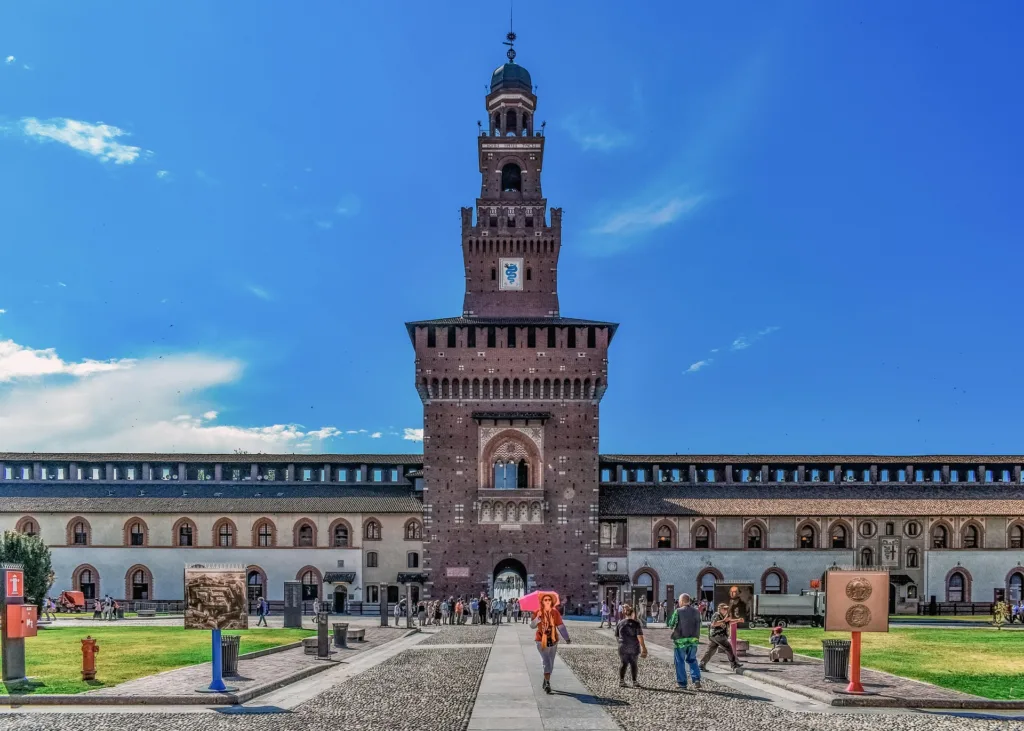
The Sforza Castle (Castello Sforzesco) and Parco Sempione are two of Milan’s most captivating landmarks, combining history, art, and a peaceful green haven. For solo travelers, this duo makes for a perfect day of cultural exploration followed by relaxation in Milan’s most popular park. Whether you’re fascinated by its Renaissance history or just looking for a scenic spot to recharge, this area has something for everyone.
Why You Should Visit Sforza Castle
- A Slice of History: Originally built in the 15th century as a fortress for the Sforza family, this castle has witnessed centuries of Milanese history and is now home to some of the city’s best museums.
- Masterpieces Inside: The castle houses several museums, including works by Michelangelo, Leonardo da Vinci, and other Italian greats. For art lovers, it’s a treasure trove!
- Architectural Beauty: The castle’s red-brick walls, majestic towers, and courtyards create a stunning visual experience—a perfect mix of medieval power and Renaissance elegance.
Why Parco Sempione Is Solo-Friendly
- A Green Escape: Tucked right behind the castle, Parco Sempione is Milan’s most beloved park. It offers wide pathways, a serene lake, and shaded nooks where solo travelers can relax.
- Perfect for Reflection: Whether journaling under a tree or people-watching by the fountain, the park provides a peaceful respite from city sightseeing.
- A Place for Photography: The park’s scenic beauty, especially the view of Arco della Pace (Arch of Peace) framed by trees, is an Instagram-worthy moment waiting to happen.
How to Experience Sforza Castle Solo
- Explore the Castle Grounds: Start with the cobblestone courtyards and the imposing castle walls. Entry to the outdoor areas is free, so you can enjoy the atmosphere even without visiting the museums.
- Visit the Museums: Buy a combined ticket (€5/$5.50 USD) to explore the collections inside, which include:
- The Pietà Rondanini, Michelangelo’s unfinished sculpture and one of the last works he created.
- Frescoes from Leonardo da Vinci and other significant artists.
- The Museum of Ancient Art, showcasing armor, tapestries, and more from Milan’s illustrious past.
- Attend a Cultural Event: The castle often hosts concerts, exhibitions, and other cultural events. Check its schedule online—you may find something unique to enjoy during your visit.
How to Experience Parco Sempione Solo
- Take a Walk Along the Lake: Stroll along the peaceful lake trail, enjoy the ducks and swans, and find a shady bench to relax.
- Climb Torre Branca: Located within the park, this steel tower offers panoramic views of Milan’s skyline. For about €5 ($5.50 USD), it’s worth the climb—or the elevator ride—for solo adventurers craving great photos.
- Discover Public Art: Wander through the park to find sculptures, fountains, and quirky artistic installations like the Mysterious Baths(Bagni Misteriosi).
- Relax by the Arch of Peace: The Arco della Pace, located at one edge of the park, provides a striking backdrop for photos. It’s a lively spot at sunset but quiet enough for solo reflection.
Practical Information
- Where Are Sforza Castle & Parco Sempione?
Located at Piazza Castello, 20121 Milan, both landmarks are centrally positioned in Milan, making them easy to reach. - How to Get There:
- By Metro: Take Line 1 (Red Line) or Line 2 (Green Line) to Cadorna Station or Line 1 to Cairoli Station—either stop is a short walk away.
- By Tram: Tram lines 4, 12, 19, and 27 all stop near the castle.
- On Foot: If you’re near Brera or the Duomo, you can reach the castle with a pleasant walk of 10-20 minutes.
- Entry Fees:
- Castle Courtyard: Free to enter.
- Museums Inside: Approx. €5 ($5.50 USD) for a combined museum ticket. Free on the first Sunday of the month.
- Opening Hours:
- The castle grounds are open daily from 7:00 AM to 7:30 PM.
- The museums inside the castle are open Tuesday to Sunday from 9:00 AM to 5:30 PM (last entry at 5:00 PM).
- Best Visiting Times:
- For a quieter experience, visit earlier in the morning or late afternoon, especially if you want tranquil moments in the park.
Highlights You Can’t Miss
- Pietà Rondanini in the Museum of Ancient Art: This hauntingly beautiful sculpture was left unfinished by Michelangelo and remains a profound reflection on mortality and life.
- Torre Branca in Parco Sempione: One of the best viewpoints in Milan, offering unmatched views of landmarks like the Duomo from above.
- The Courtyards: Perfect for wandering solo with their grand arches, cobblestone paths, and echoes of history.
- The Hidden Gems in the Park: Discover little surprises such as the Roman Bridge or the calm footpath leading to Arco della Pace.
Insider Tips for Solo Travelers
- Bring a Picnic: Grab fresh Italian snacks before arriving and enjoy them near the lake or under the large oak trees in Parco Sempione.
- Download a Self-Guided Tour App: There are apps available that share fascinating stories about the castle’s history, making it easy to explore at your pace.
- Evening Ambiance: Parco Sempione is magical at sunset. The golden hour lighting over the Arch of Peace creates a serene vibe you won’t want to miss.
- Safe and Welcoming: Both the castle and the park feel safe and tourist-friendly during the day. For nighttime walks, stick to well-lit areas and the castle grounds.
Did You Know?
- The Sforza Castle was almost demolished in the 19th century, but city planners decided to restore it instead, giving Milan one of its most cherished landmarks.
- Parco Sempione is Milan’s largest park and was landscaped in the style of an English garden, complete with winding paths and open meadows.
- The Mysterious Baths sculpture in the park is an abstract and quirky installation that often catches visitors by surprise—it’s a favorite among art lovers.
Why You will Love It
- A Fusion of Activities: You can dive into art, history, or simply unwind in nature all in one visit.
- Easy to Explore at Your Pace: With so much open space and quiet corners, you can enjoy the experience however you like.
- Blend of Energy and Calm: The castle’s cultural buzz pairs wonderfully with the park’s relaxed atmosphere, offering something for every travel mood.
The Sforza Castle and Parco Sempione offer a perfect mix of culture and calm, making it an essential stop for solo travelers in Milan. Whether you’re marveling at Renaissance beauty, taking in views from the Torre Branca, or simply finding peace under the trees, this experience is guaranteed to leave a lasting impression.
5. Navigli Canals: Scenic Charm and Vibrant Nightlife
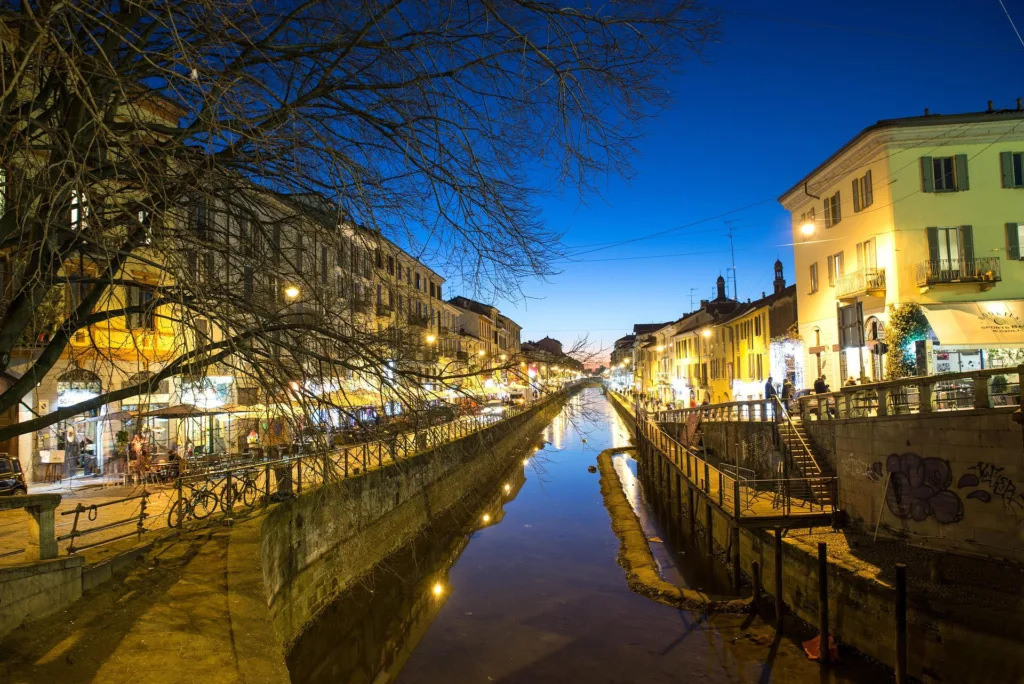
Image by pippocucu
The Navigli Canals showcase a completely different side of Milan—one that’s relaxed, artistic, and undeniably romantic. Known for their historic waterways, cozy cafés, and lively aperitivo scene, the Navigli district offers a perfect escape from Milan’s more fast-paced neighborhoods. For solo travelers, it’s a place to unwind during the day, soak up vibrant nightlife, and find inspiration around every corner.
Why Navigli Is a Must-Visit
- Historic Canals: The Naviglio Grande and Naviglio Pavese canals date back to the 12th century and were once designed by Leonardo da Vinci to support Milan’s trade routes. Today, they remain a central part of the district’s charm.
- Artistic Ambiance: The streets surrounding the canals are dotted with local galleries, vintage shops, and artisan boutiques, making it a hub for creative energy.
- Aperitivo Culture: Navigli is Milan’s aperitivo capital, with countless canal-side bars serving drinks and snacks during golden hour. It’s the go-to place to experience Milan like a local.
How to Experience Navigli Solo
- Take a Leisurely Stroll: Walk along the canals and lose yourself in the scenic surroundings. Early mornings offer tranquility, while evenings invite a lively atmosphere. Solo travelers can enjoy the combination of bustling cafes and quiet corners for reflection.
- Explore the Vintage Scene: Visit specialty shops and antiques stores, especially along Ripa di Porta Ticinese and Alzaia Naviglio Grande. The unique finds here make for meaningful souvenirs.
- Join the Aperitivo Scene: Grab an outdoor seat at one of the many bars, order a classic Aperol Spritz, and enjoy the small bites served alongside. Try Mag Café or Fonderie Milanesi for stylish yet solo-friendly vibes.
- Visit the Navigli Antique Market (last Sunday of the month): This sprawling market offers everything from vintage furniture to handmade jewelry. It’s a haven for treasure hunters and perfect for wandering solo.
Practical Information
- Where Are the Navigli Canals?
The Navigli district is located in the southwestern part of Milan, centered around Naviglio Grande and Naviglio Pavese. - How to Get There:
- By Metro: Take Line 2 (Green) to Porta Genova Station. From there, the canals are just a short walk.
- By Tram: Tram lines 2, 3, and 9 all have stops near the Navigli area.
- On Foot: If you’re staying in Milan’s city center, it’s about a 20-30 minute walk to the canals.
- Costs:
Visiting Navigli is free, but you’ll want to budget for food, shopping, or aperitivo drinks, which typically range from €8 to €15 ($9-$16 USD). - Best Time to Visit:
- Morning for quiet strolls and peaceful canal views.
- Late afternoon for the vibrant aperitivo culture that starts around 6 PM.
Highlights of the Navigli District
- Naviglio Grande: The largest and most famous canal, perfect for walking, dining, or simply soaking up the waterfront charm.
- Church of Santa Maria delle Grazie al Naviglio: A picturesque yet tranquil landmark to explore near the canal.
- Fondazione Arnaldo Pomodoro: A contemporary art foundation featuring rotating exhibits by modern artists—it’s a unique creative experience for solo visitors.
- Boat Tours: Hop on a short canal cruise for a guided tour of this historic area. Tickets cost approximately €10-15 ($11-$16 USD).
Insider Tips for Solo Travelers
- Explore in the Morning: Beat the crowds with an early morning visit when the streets are quieter, and the canals reflect the soft light of the rising sun.
- Grab Aperitivo Early: Popular bars fill up fast during aperitivo hour (6 PM to 9 PM). Arrive early for a good spot with a canal-side view.
- Carry Cash: Many of the antique market stalls and smaller boutique shops prefer cash over cards.
- Stay Aware at Night: Navigli is generally safe, but it’s always wise to stick to well-lit, busier areas if you’re out late. Use rideshare apps or public transport to head back to your accommodation.
Did You Know?
- Once Functional Canals: The Navigli network was integral to transporting materials like marble used in building the Duomo.
- Leonardo’s Influence: While Leonardo da Vinci didn’t design the canals, he helped refine the system using innovative techniques to regulate water flow.
- Beloved by Artists: Navigli has long been a hotspot for Milan’s creative community, attracting writers, painters, and photographers alike.
Why Solo Travelers Love Navigli
- Laid-Back Energy: Navigli’s relaxed vibe is a welcome contrast to the busy city center, allowing solo visitors to unwind and explore at their own pace.
- Social Opportunities: The lively aperitivo culture makes it easy to strike up conversations with locals or fellow travelers.
- Variety of Experiences: Whether you’re shopping for vintage treasures, capturing stunning photos, or enjoying a meal by the water, Navigli offers something for every mood.
The Navigli Canals are a perfect blend of history, culture, and modern Milanese lifestyle. As a solo traveler, you can wander its scenic streets, enjoy a quiet coffee break, or dive into the vibrant nightlife—all in one visit. It’s a neighborhood that feels like a little escape within the city, giving you a taste of Milan’s charming contrasts.
6. Pinacoteca di Brera Art Gallery: Milan’s Artistic Treasure
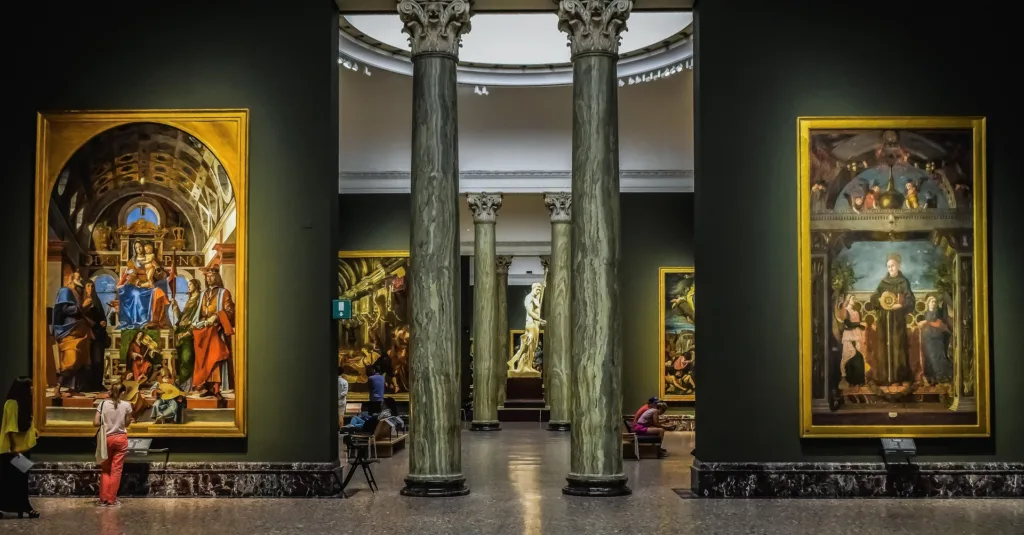
The Pinacoteca di Brera is more than just an art gallery—it’s a gateway into Milan’s rich cultural and artistic heritage. Located in the heart of the charming Brera district, this world-class museum houses an impressive collection of Italian masterpieces, including works by Raphael, Caravaggio, and Tintoretto. For solo travelers, the Pinacoteca offers a serene and reflective experience where you can fully immerse yourself in the beauty of timeless art.
Why You Should Visit the Pinacoteca di Brera
- Masterpieces Everywhere: The gallery is home to some of the most significant works of Italian art, including Raphael’s The Marriage of the Virgin and Caravaggio’s Supper at Emmaus.
- Peaceful Atmosphere: With its dim lighting and quiet halls, the gallery provides a calm and contemplative space that’s perfect for solo travelers to enjoy at their own pace.
- A Dive into Renaissance Culture: The collection spans centuries, giving visitors a glimpse into the evolution of Italian art from the medieval period to the 18th century. It’s a must-see for anyone wanting to feel connected to Milan’s creative spirit.
How to Experience the Pinacoteca di Brera Solo
- Start with the Highlights: As a solo traveler, you can take your time admiring key works like:
- Raphael’s The Marriage of the Virgin: One of the gallery’s most famous pieces and an exquisite showcase of Renaissance art.
- Caravaggio’s Supper at Emmaus: A mesmerizing depiction of biblical emotion and light.
- Piero della Francesca’s The Dead Christ: Renowned for its striking anatomical perspective.
- Wander Without a Guide: The gallery’s layout is easy to navigate, making it ideal for those who prefer unstructured exploration over formal tours. Feel free to linger where a piece captivates you.
- Use the Free Touchscreens: Throughout the gallery, interactive displays provide insights into the artworks, their history, and the artists’ contributions. These are perfect for solo visitors who want to deepen their understanding.
- Step Outside to the Courtyard: Before leaving, pause in the peaceful courtyard featuring a statue of Napoleon Bonaparte, one of Brera’s most photographed spots.
Practical Information
- Where Is It Located?
The Pinacoteca di Brera is in the Brera district, at Via Brera, 28, 20121 Milan. The area is known for its cobblestone streets, bohemian charm, and buzzing cafes. - How to Get There:
- By Metro: Take Line 3 (Yellow Line) to Montenapoleone Station, then walk about 10 minutes.
- By Tram: Tram lines 1, 2, 12, and 14 stop nearby.
- On Foot: If you’re exploring Brera, the Pinacoteca is easy to reach from anywhere in the district.
- Entry Fees:
- General ticket: Approx. €15 ($16.50 USD).
- Reduced ticket (EU citizens under 25 years): Approx. €2 ($2.20 USD).
- Free entry on the first Sunday of every month!
- Opening Hours:
- Typically open Tuesday to Sunday from 8:30 AM to 7:15 PM, with the last entry at 6:40 PM.
- Closed on Mondays.
Highlights You Can’t Miss
- Raphael’s The Marriage of the Virgin: A stunning Renaissance masterpiece renowned for its delicate colors and perfect symmetry.
- Caravaggio’s Supper at Emmaus: A dramatic portrayal of light and shadow that exemplifies Caravaggio’s mastery of realism.
- Francesca Hayez’s The Kiss: Considered a symbol of Italian romanticism, this painting is a highlight that reflects themes of love and patriotism.
- The Cloister and Courtyard: An oasis of calm with a beautiful mix of Renaissance architecture and leafy greenery.
Insider Tips for Solo Travelers
- Visit Early for Peaceful Exploration: Arrive at opening hours to enjoy quieter galleries and uninterrupted reflection on masterworks.
- Bring a Journal: The stunning works and tranquil atmosphere make this an ideal place to jot down thoughts or sketches inspired by your visit.
- Download the Brera App: This free app provides detailed explanations of the artworks and their significance, making your visit richer and more engaging.
- Pair It with a Stroll Through Brera: After your visit, wander nearby streets like Via Fiori Chiari to enjoy charming shops, art galleries, and cozy cafes suited for solo travelers.
Did You Know?
- The Pinacoteca di Brera was originally established in 1776 to train art students at Milan’s Academy of Fine Arts, which still occupies part of the building today.
- Napoleon Bonaparte played a key role in enriching the museum’s collection by centralizing works confiscated from churches and aristocratic families during his reign.
- Pinacoteca di Brera not only displays works of art but also actively participates in restoration projects, preserving Italian history for future generations.
Why Solo Travelers Love It
- A Space for Reflection: The gallery’s serene halls make it an ideal place for solo visitors to connect with art without distractions.
- Go at Your Own Pace: Unlike busy attractions, the Pinacoteca feels spacious and allows you to enjoy it without feeling rushed.
- The Perfect Brera Pairing: Combine your visit with a leisurely walk through the surrounding neighborhood for a full day of art and culture.
The Pinacoteca di Brera is more than just a museum—it’s a journey through Italy’s artistic heritage. For solo travelers, it offers a chance to slow down and deeply appreciate Milan’s cultural side at your own pace.
7. Porta Nuova and Bosco Verticale: Milan’s Modern Marvels Skyscrapers
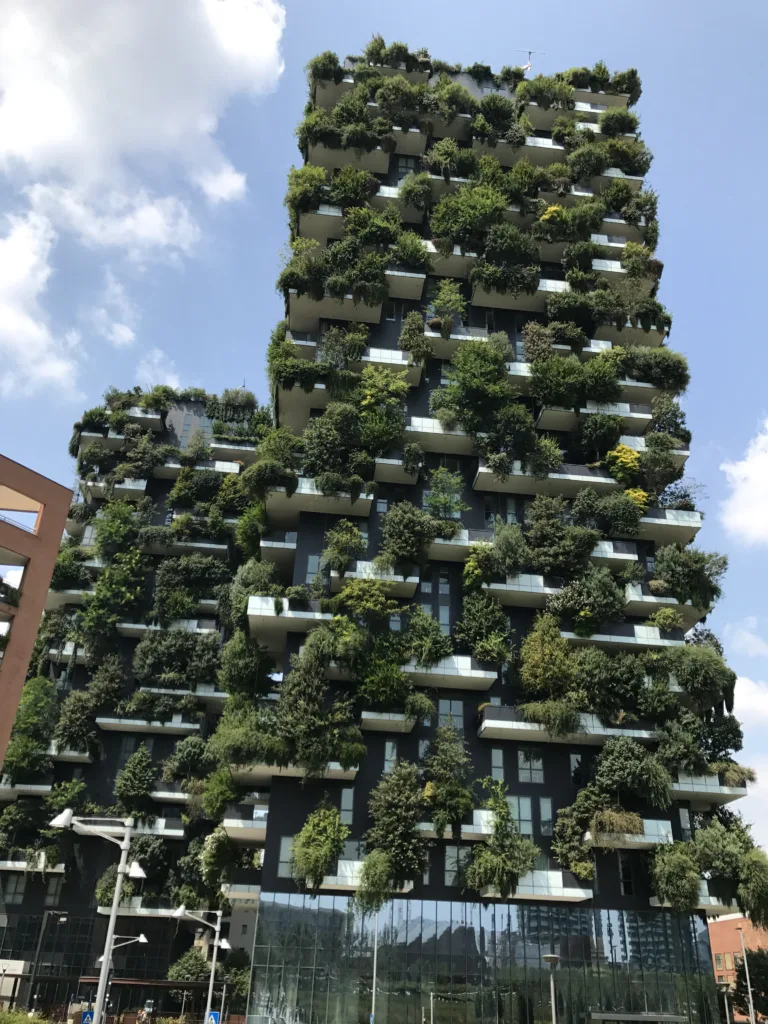
By Darsheni – Own work, CC BY-SA 3.0, Link
Milan is a city where the past and the future coexist beautifully, and nowhere is this more evident than in the Porta Nuova district. Known for its bold modern architecture and sustainability initiatives, this area is a must-visit for solo travelers who appreciate innovation and sleek urban design. At the heart of it all lies the Bosco Verticale (Vertical Forest), an architectural masterpiece that has redefined modern living and set a global benchmark for eco-friendly design.
Why Porta Nuova and Bosco Verticale Are a Must-See
- A Glimpse into the Future: Porta Nuova is Milan’s most modern neighborhood, with gleaming skyscrapers, pedestrian-friendly plazas, and cutting-edge sustainable architecture that brings a fresh perspective to the city.
- Bosco Verticale (Vertical Forest): These award-winning residential towers are covered with thousands of plants, creating a living, breathing forest in the sky. It’s a visual treat and a symbol of Milan’s commitment to greener urban living.
- Energetic Yet Relaxed Vibes: Despite its modernity, Porta Nuova feels welcoming and spacious, offering plenty of opportunities for solo travelers to explore at their own pace.
How to Experience Porta Nuova Solo
- Marvel at Bosco Verticale: Start your visit by admiring the Vertical Forest from the surrounding piazza. These two towers (home to over 900 trees and 20,000 shrubs) are best appreciated up close, where you can see how nature and architecture coexist.
- Explore Piazza Gae Aulenti: Just a short walk from Bosco Verticale, this futuristic plaza serves as the beating heart of Porta Nuova. Relax by the fountains, admire the reflective surfaces, or grab a coffee at one of the stylish cafes.
- Walk the High Line (La Biblioteca degli Alberi): Stroll through this innovative urban park next to Bosco Verticale, which connects green spaces, modern architecture, and outdoor art installations. Solo travelers will love its quiet pathways for reflection and leisurely exploration.
- Capture Photos: With its bold modern designs, sharp lines, and reflective glass facades, Porta Nuova is incredibly photogenic. Early mornings or golden hour (just before sunset) provide the best light.
Practical Information
- Where Is It Located?
Porta Nuova and Bosco Verticale are located in Milan’s northern center, around the Isola and Garibaldi neighborhoods. - How to Get There:
- By Metro: Take Line 2 (Green Line) or Line 5 (Purple Line) to Garibaldi FS or Isola Station—both stops provide easy access.
- By Tram: Tram lines 2, 10, 33, and 37 all serve the area.
- On Foot: If you’re exploring from the Duomo, it’s about a 25-minute walk through the city streets.
- Entry Fees:
- Bosco Verticale is a residential building and not open to the public, but all surrounding spaces like Piazza Gae Aulenti and the High Line Park are free to enjoy.
- Best Times to Visit:
- Early morning for quieter streets and optimal lighting for photography.
- Evenings for a lively but relaxed atmosphere when the piazza lights up beautifully.
Highlights You Can’t Miss
- Bosco Verticale: Stroll around the base of these towers for a close-up view of the trees, shrubs, and balconies that make these buildings so unique. It’s a photographer’s dream!
- Piazza Gae Aulenti: One of Milan’s most futuristic squares, featuring fountains, reflective pools, and incredible views of the surrounding skyscrapers.
- La Biblioteca degli Alberi: This innovative urban park connects art, nature, and modernity. The tree-lined paths and minimalist landscaping are perfect for solo strolls or quiet reflection.
- The Unicredit Tower: Italy’s tallest building and another symbol of modern Milan. Its curved design makes it one of the most recognizable structures in the city.
Insider Tips for Solo Travelers
- Walk Between Neighborhoods: Porta Nuova serves as the perfect corridor between Isola and Garibaldi, making it easy to combine visits to all three. Take time to explore these bordering districts.
- Plan for Sunset: The area lights up dramatically as the sun sets, with the towers and piazza reflecting golden hues. Stick around for this magical time if you’re a fan of evening photography.
- Bring a Book or Journal: La Biblioteca degli Alberi’s peaceful green spaces are ideal for escaping the noise of the city center and enjoying some solo downtime.
- Combine with Nearby Dining and Drinks: Porta Nuova is full of modern bars and restaurants. Try an aperitivo at 10 Corso Como Cafe, a stylish spot blending art and cuisine just nearby.
Did You Know?
- Bosco Verticale hosts over 100 different plant species, creating a self-sustaining ecosystem that reduces pollution and enhances biodiversity in the city.
- Porta Nuova’s redevelopment transformed what was once an industrial area into one of Europe’s most advanced urban renewal projects, earning global recognition for its innovative design.
- The Unicredit Tower, resembling a spiral, reaches 231 meters (758 feet) high and lights up with different colors to celebrate special events in Milan.
Why Solo Travelers Love Porta Nuova
- Spacious and Peaceful: Despite its popularity, Porta Nuova’s pedestrian spaces never feel overwhelming, making it easy for solo travelers to explore or relax.
- Modern and Safe: The sleek, open design of the district, combined with plenty of public seating and green spaces, caters perfectly to travelers looking for a contemporary yet welcoming vibe.
- Visually Stunning: From Bosco Verticale to Piazza Gae Aulenti, every corner of this neighborhood offers something worth capturing—whether through a camera lens or just your own eyes.
The Porta Nuova district and Bosco Verticale are proof that Milan isn’t just about history—it’s a city that continually looks to the future. For solo travelers, this cutting-edge area offers the perfect mix of innovation, beauty, and calm, with plenty of opportunities to reflect, recharge, and capture unforgettable memories.
8. Teatro alla Scala Opera House: A Masterpiece of Milan’s Cultural Scene
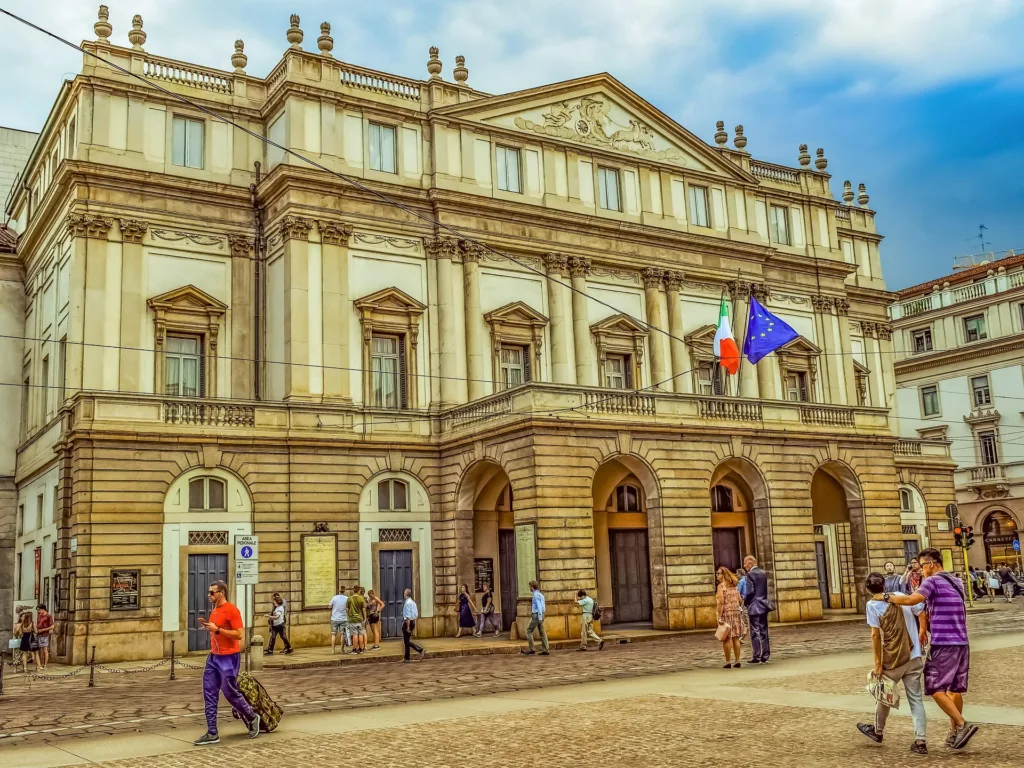
Teatro alla Scala is far more than an opera house—it’s a living, breathing symbol of Milan’s devotion to the arts. Known worldwide as the temple of opera, La Scala has hosted legendary performances by icons like Giuseppe Verdi and Luciano Pavarotti, leaving an indelible mark on music history. For solo travelers, visiting La Scala offers a deeply personal glimpse into Italy’s cultural elegance and Milan’s artistic soul.
Why Teatro alla Scala Is a Must-See
- An Opera Lover’s Dream: Dating back to 1778, La Scala has been the arena for grand premieres by world-class composers such as Rossini, Puccini, and Verdi. Its prestige remains unmatched, with each performance drawing opera enthusiasts from across the globe.
- Rich History and Legacy: The theater is steeped in centuries of tradition, surviving wars and evolving through eras. It embodies Milan’s resilience and passion for the performing arts.
- Breathtaking Architecture: The grandeur of La Scala’s interiors will leave you in awe. Think velvet seats, golden balconies, intricate frescoes, and glittering chandeliers—every corner tells a story of luxury and artistry.
- Cultural Connection: Even if you’re not an opera fan, visiting La Scala transports you to a world of elegance and creativity that’s integral to understanding Milan’s identity.
How to Experience Teatro alla Scala Solo
- Tour the Museo Teatrale alla Scala: Take a self-guided journey through this fascinating museum, which showcases rare costumes, set designs, and musical instruments. It’s the perfect way to dive into the history of opera as a solo traveler, exploring at your own pace.
- Attend an Opera or Ballet Performance: Fully immerse yourself in the magic of live art. La Scala’s impeccable acoustics and captivating productions make for an unforgettable solo experience.
- Admire the Auditorium: Even without attending a performance, visitors can glimpse its iconic red-and-gold interiors during museum tours. The sight is nothing short of magical.
- Wander Piazza della Scala: The vibrant square just outside La Scala is perfect for a reflective stroll or quiet people-watching after your visit.
Practical Information to Plan Your Visit
Where Is It?
Teatro alla Scala is centrally located in Piazza della Scala, close to the Duomo and Galleria Vittorio Emanuele II.
How to Get There:
- By Metro: Take Line 3 (Yellow) to Montenapoleone or Line 1 (Red) to Duomo—both are a short walk away.
- By Tram: Lines 1, 2, and 12 stop near the opera house.
- On Foot: From the Duomo, it’s just a 5-minute walk through the Galleria Vittorio Emanuele II.
Costs:
- Museum Access: Approx. €10 ($11 USD).
- Performance Tickets: Prices vary widely, starting at approximately €30 and going up to over €250 for premium seats.
Opening Hours:
- Museum: Open daily from 9:30 AM to 5:00 PM, with the last admission at 4:30 PM.
- Performances: Evening shows generally begin at 7:30 PM.
Accessibility:
The theater is wheelchair accessible, and elevators are available for reaching upper levels during performances or tours.
Highlights You Can’t Miss
- The Auditorium: The heart of the theater, with opulent red velvet, golden detailing, and enchanting chandeliers.
- The Museum: Home to rich memorabilia, including Verdi’s handwritten scores and costumes worn by legendary performers.
- The Palchi (Private Boxes): Gaze up at the magnificent private boxes, once filled with Milanese aristocrats.
- Stage Machinery: Known for its state-of-the-art technical capabilities, it’s one of the most advanced stages in Europe.
- A Gala Performance: If you’re lucky to attend, you’ll witness opera or ballet in one of the most prestigious cultural venues worldwide.
Nearby Attractions for Solo Travelers
After your visit, make the most of your time exploring these nearby landmarks:
- Piazza della Scala: Home to the Leonardo da Vinci statue and surrounded by atmospheric cafes.
- Galleria Vittorio Emanuele II: Just steps away, this glamorous arcade is ideal for a stroll or a coffee break.
- Museo del Novecento: A short walk from La Scala, it offers a stunning collection of 20th-century Italian art.
Did You Know?
- Historical Ties: Teatro alla Scala was named after the Church of Santa Maria alla Scala, demolished in 1776 to make way for the theater.
- Verdi’s Legacy: Giuseppe Verdi’s connection to La Scala is legendary. His opera Nabucco debuted here in 1842, cementing his position as Italy’s greatest composer.
- Bombing and Restoration: La Scala was heavily damaged during World War II but was painstakingly restored and reopened in 1946.
- Acoustic Brilliance: The theater’s acoustics are so advanced that every seat offers clarity, even in the gallery’s highest rows.
- Dress Code Tradition: While modern audiences can wear smart casual attire, traditionally, attending La Scala meant sophisticated evening dresses and tuxedos.
Teatro alla Scala isn’t just a destination—it’s an experience that immerses you in Milan’s cultural heartbeat. Whether you lose yourself in an opera’s soaring melodies, marvel at centuries of history in the museum, or simply admire its dazzling interiors, La Scala offers an unforgettable journey. For the solo traveler, this iconic venue promises more than a visit—it’s a moment of connection with Milan’s artistic soul.
9. Monumental Cemetery (Cimitero Monumentale): An Open-Air Museum
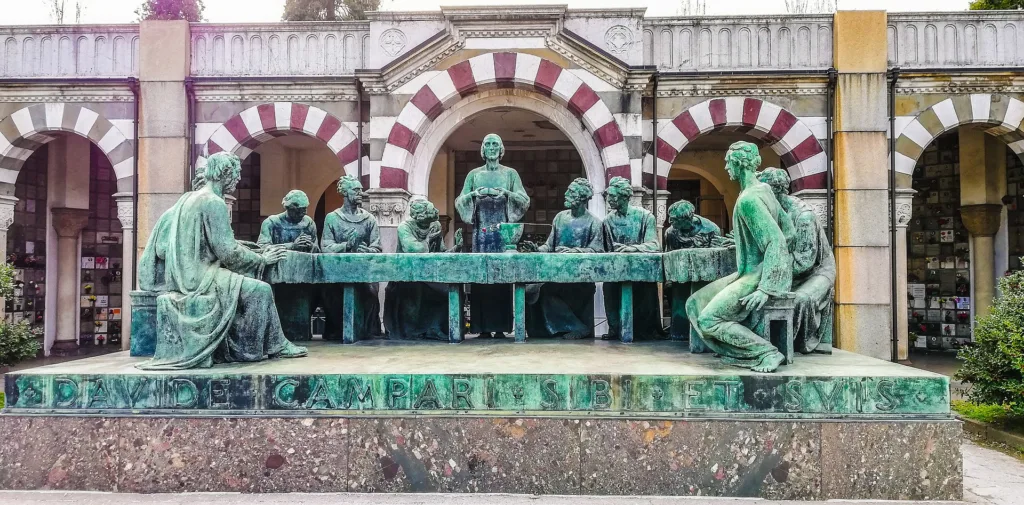
By Ivan Stesso – Own work, CC BY-SA 4.0, Link
At first mention, a cemetery might not seem like an attraction, but Milan’s Cimitero Monumentale is unlike any other. Situated in the northern part of the city, this sprawling cemetery is less a burial ground and more an outdoor museum of art and design. Known for its breathtaking sculptures, grand mausoleums, and intricately designed tombs, it stands as one of Milan’s most surprising and captivating landmarks.
For solo travelers, the Monumental Cemetery offers a rare blend of tranquility and inspiration. Away from the bustling streets of Milan, it invites you to reflect, explore, and marvel at the artistry of some of Italy’s finest architects and sculptors.
Why the Monumental Cemetery Is a Must-See
- A Showcase of Architectural Brilliance: From Gothic angels to Art Deco crypts, every tomb and mausoleum reflects Milan’s rich history of craftsmanship and design.
- A Walk Through Milan’s History: The cemetery is the final resting place of several prominent figures, including artists, industrialists, and political leaders, whose lives shaped Milan’s legacy.
- A Serene Escape: Unlike the more crowded landmarks in the city center, the peaceful paths and exquisite surroundings of Cimitero Monumentale allow visitors to slow down and take in its beauty without interruptions.
- Perfect for Reflection: For solo travelers, the cemetery offers a quiet space to think, wander, and connect with Milan’s artistic and historical roots.
How to Experience the Monumental Cemetery Solo
- Marvel at the Grand Entrance: The Famedio, or Temple of Fame, is the towering marble structure that greets visitors. Here, you’ll find tributes to Milan’s most influential citizens, including the famed novelist Alessandro Manzoni.
- Explore the Sculptures: Each tomb is more than a grave—it’s a work of art. Angelic figures, weeping women, and symbolic carvings turn the cemetery into a gallery of life, death, and hope.
- Visit Notable Graves: Look for the tombs of pivotal Milanese figures, such as Arturo Toscanini, the celebrated conductor, and Alessandro Manzoni, Italy’s literary giant.
- Take Your Time: Stroll among the intricate designs of family mausoleums and embrace the calm of this vast, open space. The experience is almost meditative, making it especially rewarding for solo travelers.
Practical Information to Plan Your Visit
Where Is It?
The cemetery is located in Piazzale Cimitero Monumentale, easily accessible from central Milan.
How to Get There:
- By Metro: Take Line 5 (Purple Line) to Monumentale station, located right near the entrance.
- By Tram: Tram lines 10 and 12 stop close by.
Costs:
- Entry is free, making it one of the best-value experiences in Milan.
Opening Hours:
- Open Tuesday through Sunday from 8:00 AM to 6:00 PM. It is closed on Mondays, so plan accordingly.
Highlights You Can’t Miss
- The Famedio: This Neo-Medieval structure pays tribute to Milan’s most celebrated citizens, complete with grand columns, inscriptions, and a unique mix of Gothic and Byzantine styles.
- Iconic Sculptures: From towering angels to elaborate family crypts, the cemetery is home to some of the finest sculptures in Milanese history. Each piece tells a story worth pausing for.
- The Jewish and Non-Catholic Sections: Reflecting Milan’s diverse cultural past, these less-visited areas showcase architectural styles and traditions distinct from the Catholic sections.
- Family Mausoleums: These grand tombs, often resembling miniature temples, reflect the wealth and influence of Milan’s industrial and aristocratic families.
Did You Know?
- The cemetery was designed by Carlo Maciachini and opened in 1866 to consolidate smaller cemeteries around the city.
- It spans an incredible 250,000 square meters, making it one of the largest cemeteries in Europe.
- Cultural tours are regularly held to highlight the artistic and historical significance of the tombs.
- The cemetery includes an Atheist section—an unusual addition in predominantly Catholic Italy—which further highlights its inclusive and progressive design.
Milan’s Cimitero Monumentale is an unexpected gem where art, history, and tranquility come together. For solo travelers, it offers a unique chance to explore Milan’s creative legacy in peace, away from the city’s hustle and bustle. Whether it’s the intricate sculptures, the grand mausoleums, or the serene atmosphere, this cemetery leaves a lasting impression, making it a destination unlike any other.
10. Colonne di San Lorenzo: Roman History Meets Modern Milan
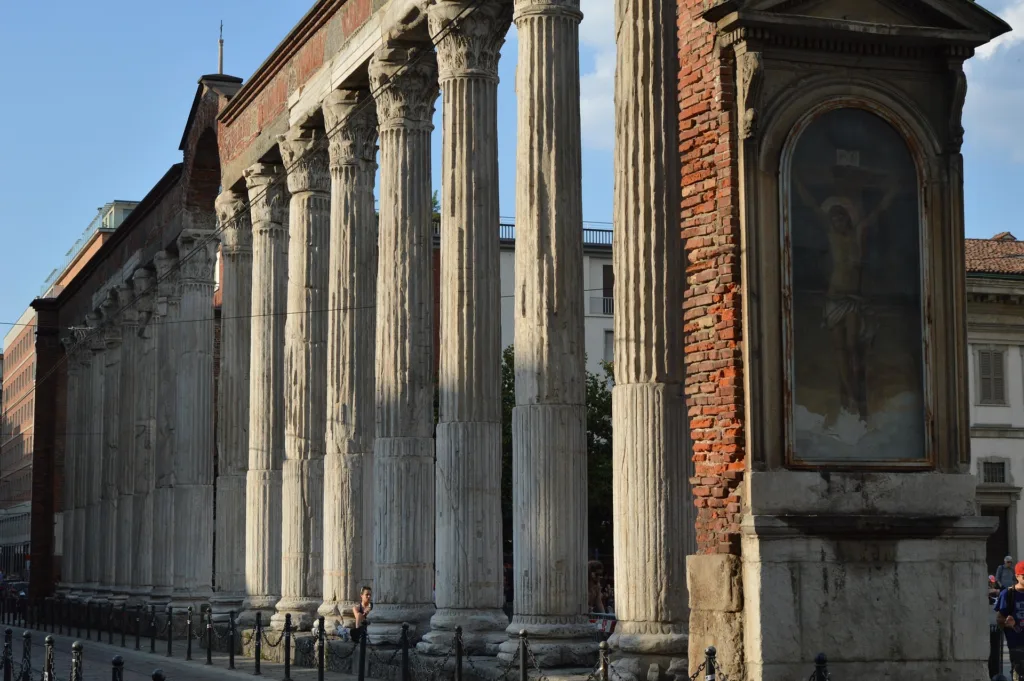
Nestled in the vibrant Porta Ticinese district, the Colonne di San Lorenzo stand as one of Milan’s most fascinating historical landmarks. These 16 towering Roman columns date back to the 2nd or 3rd century AD, making them a rare and enduring relic of ancient Milanese history. Yet, what makes this site truly special is how it seamlessly blends antiquity with the lively energy of modern Milan.
For solo travelers, the Colonne di San Lorenzo offers a unique experience—immerse yourself in centuries of history while soaking in the friendly, social atmosphere of the surrounding square.
Why the Colonne di San Lorenzo Is a Must-See
- A Rare Piece of Roman History: As one of the few surviving remnants of Roman Mediolanum (ancient Milan), these columns allow visitors to trace the city’s roots back nearly 2,000 years.
- Lively Piazza Setting: Day or night, the piazza surrounding the Colonne is animated with locals and travelers alike, mingling at nearby cafes and bars.
- Perfect Contrast of Old and New: The juxtaposition of ancient Roman columns with Porta Ticinese’s vibrant urban life makes this site distinctly Milanese.
- An Iconic Gathering Place: For centuries, the Colonne have served as a meeting point for locals, a tradition that continues today in Milan’s youthful social scene.
How to Experience Colonne di San Lorenzo Solo
- Absorb the Ancient Atmosphere: Spend quality time walking among the columns, admiring the textures of the marble and imagining the Roman temple or bathhouse they were once part of.
- Visit Basilica di San Lorenzo Maggiore: Just steps away, this stunning basilica adds extra historical significance to the area and is an equally rewarding stop for architecture enthusiasts.
- Relax in the Piazza: Bring a book or grab a coffee from a nearby café and enjoy the relaxed vibe. The piazza is perfect for people-watching and soaking in Milan’s youthful energy.
- Embrace the Nightlife: In the evenings, the area comes alive with live music, street performances, and locals unwinding with aperitivos, making it a fun yet safe environment for solo travelers.
Practical Information to Plan Your Visit
Where Is It?
The Colonne di San Lorenzo are located in front of the Basilica di San Lorenzo Maggiore in the Porta Ticinese area.
How to Get There:
- By Metro: Take Line 3 (Yellow Line) to the Missori station, followed by a 10-minute walk.
- By Tram: Trams 3, 9, and 10 stop conveniently near the piazza.
- On Foot: It’s easily accessible for those exploring the city center, being around 15-20 minutes from Piazza del Duomo.
Costs: Free to access, any time of day.
Opening Hours: Open 24/7, as the piazza is a public space. However, the Basilica follows specific visitor hours.
Highlights You Can’t Miss
- The Columns Themselves: These 16 marble columns are intricately detailed and remarkably well-preserved for their age.
- The Basilica di San Lorenzo Maggiore: A stunning basilica steeped in history, with a mix of Roman and early Christian architectural influences.
- The Statue of Emperor Constantine: Directly in front of the Basilica, the statue is a nod to Constantine’s Edict of Milan, which allowed for religious freedom in 313 AD.
- The Vibrant Piazza Scene: By day, the square exudes a laid-back vibe, while the energy turns electric in the evening, with locals and visitors gathering to enjoy the nightlife.
Did You Know?
- The Colonne were relocated to their current position in the 4th century AD as part of an ambitious reconstruction project under Roman Emperor Theodosius I.
- Despite their ancient origins, the Colonne have weathered wars, invasions, and Milan’s urban expansions, standing as a silent witness to the city’s evolution.
- During the Renaissance, the area around the Colonne became a hub for public speeches and debates, continuing its tradition as a gathering spot.
- At night, the columns are beautifully lit, offering a completely different, almost magical atmosphere for visitors.
The Colonne di San Lorenzo perfectly encapsulate Milan’s ability to honor its ancient roots while thriving as a modern city. Whether you visit during the day to embrace its historic significance or at night to enjoy the lively atmosphere, this site offers something unique for every solo traveler. It’s a place where history and modernity coexist in perfect harmony, making it a must-see on any Milan itinerary.
Hidden Gems of Milan: Uncovering the City’s Lesser-Known Treasures
Milan is celebrated for its iconic landmarks like the Duomo and The Last Supper, but beyond its famous attractions lies a collection of lesser-known places that tell a quieter, more intimate story of the city. These hidden gems offer a glimpse into Milan’s depth—full of artistry, history, and charm that many visitors overlook.
For solo travelers, exploring these unique locations is more than just sightseeing—it’s an invitation to experience Milan in its most authentic and unexpected ways. From the hauntingly beautiful San Bernardino alle Ossa, to the tranquil elegance of Villa Necchi Campiglio, and the bold murals of Porta Ticinese Street Art, these spots promise to add something truly special to your journey.
1. San Bernardino alle Ossa Church : A Hidden Sanctuary of Haunting Beauty

By Paolobon140 – Own work, CC BY-SA 4.0, Link
In the bustling heart of Milan, just steps from the grandeur of the Duomo, lies a chapel unlike any other—San Bernardino alle Ossa. While most travelers flock to the iconic cathedral or picturesque Navigli canals, those with an adventurous spirit and curiosity for the unusual find themselves captivated by this beautifully eerie hidden gem.
Peering into this unassuming 13th-century chapel feels like uncovering a secret piece of Milan’s past. Its ossuary is a visually arresting collection of human skulls and bones meticulously arranged along the walls, carrying whispers of faith, mortality, and tradition. For those willing to venture beyond the beaten path, San Bernardino offers a quiet, reflective experience steeped in history and intrigue.
What Makes It a Hidden Gem?
- Understated Yet Intriguing: Unlike Milan’s towering landmarks with their crowds and grandeur, San Bernardino is understated from the outside—a secret best appreciated when stumbled upon.
- The Emotional Impact of Its Ossuary: The sight of human remains displayed as art evokes reflection and curiosity. Few visitors expect such an expressive display of faith and mortality tucked away so close to Milan’s bustling city center.
- Overlooked by Tourists: Despite being just minutes from the Duomo, the chapel remains unknown to many, offering a rare opportunity for an undisturbed, intimate experience.
- Spiritual and Artistic Contrast: The starkness of the bones is balanced with the beauty of the Baroque artwork, creating a mix of austerity and elegance that’s rarely found elsewhere.
Why You Should Visit
- A Personal Journey: Exploring San Bernardino offers a deeply personal experience, giving solo travelers the space to process its visual and emotional impact free from distraction.
- A Moment of Solitude: With fewer visitors, this tiny chapel provides a peaceful pause away from Milan’s livelier attractions, making it ideal for self-reflection.
- An Intimate Connection to History: Walking among the ossuary walls feels like stepping into an unfiltered piece of history that has remained unchanged for centuries—a rare moment of timelessness for a curious traveler.
Practical Details to Discover This Gem
Where Is It?
San Bernardino alle Ossa is located just behind Piazza Santo Stefano, a short walk from Piazza del Duomo.
How to Get There:
- By Metro: Take Line 1 (Red Line) or Line 3 (Yellow Line) to the Duomo stop, then walk for 5–10 minutes.
- By Foot: If you’re near the Duomo, finding this hidden gem is easy and adds a sense of discovery to your day.
Costs: Entrance is free, though donations are welcomed to maintain the site.
Opening Hours: Open from 7:30 AM to 12:00 PM, then 2:30 PM to 6:00 PM daily (closed on Sundays).
What You’ll Find Inside
- A Gothic Ossuary: Human skulls and bones meticulously arranged in crosses and decorative patterns line the walls, creating a stunning yet somber visual impact.
- A Baroque Ceiling: Look up to admire the fresco by Sebastiano Ricci, where angels ascend, adding softness to the starkness below.
- A Quiet Stillness: The chapel’s peaceful ambiance enhances the sense of discovery, making it a perfect place to absorb its beauty at your own pace.
Why It’s Special
Unlike most of Milan’s renowned landmarks, San Bernardino is for those seeking something different—a place where spirituality meets the artistic and the macabre. It’s not on the typical itineraries, but that’s precisely why it’s an unforgettable experience for the adventurous traveler.
A Hidden Story Worth Uncovering
- Built from Necessity: The ossuary was created when a nearby cemetery ran out of space during a plague, turning bones into reverent art.
- A Haunting Legacy: The arrangement of human remains isn’t just practical—it reflects centuries of faith and artistry unique to Catholic tradition.
- An Underrated Attraction: Located just minutes from some of Milan’s biggest sites, it remains one of the city’s best-kept secrets, waiting for the curious explorer.
San Bernardino alle Ossa is more than a chapel—it’s a chance to step into an alternative side of Milan, where art, history, and spirituality intertwine in ways both haunting and beautiful. For solo travelers, it offers moments of quiet reflection and awe, a break from the crowds, and a story to carry with them long after they leave.
2. Villa Necchi Campiglio: Milan’s Hidden Haven of Elegance
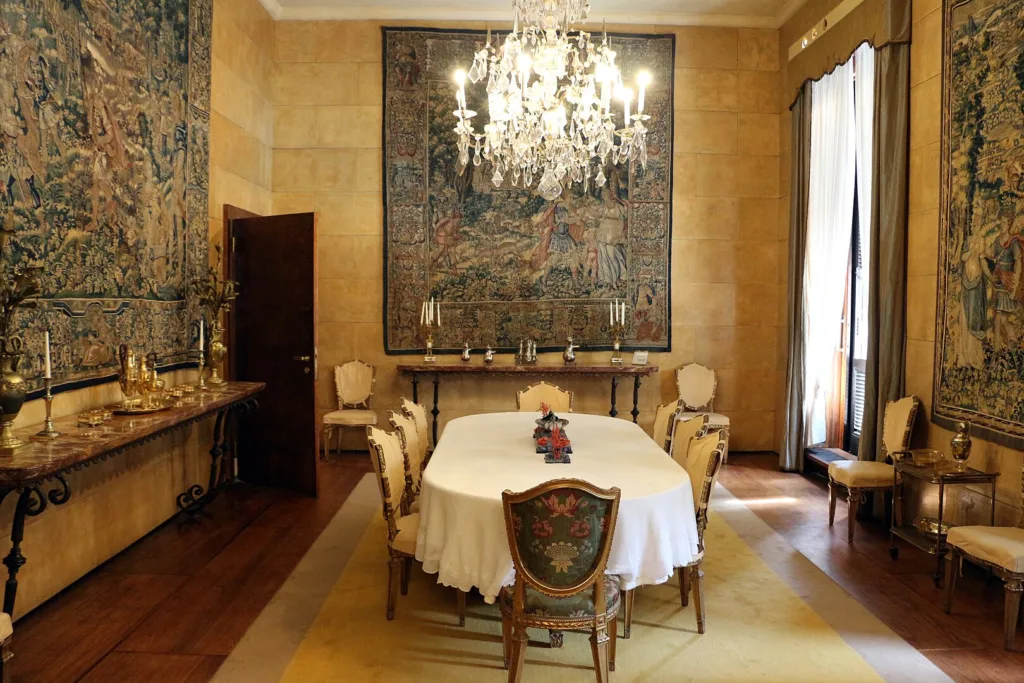
Di Sailko – Opera propria, CC BY 3.0, Collegamento
Nestled away from Milan’s busy streets lies Villa Necchi Campiglio, a rare glimpse into the refined world of Milan’s aristocracy. Surrounded by lush gardens and steeped in serene beauty, this 20th-century mansion feels like stepping into a sanctuary frozen in time. While Milan is known for its grandeur and flash, this villa offers something quieter—a taste of understated luxury and the indulgent lifestyle once reserved for high society.
A visit here is perfect for solo travelers seeking peaceful discovery. Far from the tourist-packed landmarks, Villa Necchi whispers stories of Milan’s golden age, blending architecture, art, and history into an intimate and deeply personal experience.
What Makes It a Hidden Gem?
- Under-the-Radar Splendor: While other Milan landmarks steal the spotlight, Villa Necchi flies under the radar, offering a space that feels undiscovered even in the heart of the city.
- Timeless Elegance: Designed by Piero Portaluppi in the 1930s, this modernist villa balances cutting-edge Art Deco with timeless luxury.
- Tranquil Surroundings: Unlike Milan’s lively squares, the villa’s private pool and lush gardens offer a peaceful retreat rarely found in the city’s center.
- Immersive History: As the former home of a wealthy Milanese family, Villa Necchi presents an authentic glimpse into an era of high-society glamour.
Why Solo Travelers Should Visit
- Explore at Your Own Pace: Without the crowds, enjoy wandering through opulent rooms and gardens quietly, savoring the intricate details of its design solo.
- Feel the Luxury: Stepping into Villa Necchi is like being a guest in a family home—not a museum. Solo travelers often find themselves marveling at its personal touches.
- A Perfect Escape: It’s the kind of place where you can breathe, reflect, and feel a world away from the busy city just outside its gates.
Practical Information to Plan Your Visit
Where Is It?
Located in the exclusive Porta Venezia district, Villa Necchi Campiglio is tucked onto Via Mozart 14, blending perfectly into a quiet residential street.
How to Get There:
- By Metro: Take Line 1 (Red Line) to Palestro station, then walk approximately 8 minutes.
- By Tram: Tram lines 9 and 19 have nearby stops.
- On Foot: If you’re exploring central Milan, the villa is around 15–20 minutes’ walk from the Duomo.
Costs:
- Entry Fees: Approx. €15 for adults. Discounts are available for youth, students, and FAI members.
- Guided Tours: Options are available and highly recommended to delve deeper into the Necchi family’s life.
Opening Hours: Generally open Wednesday through Sunday, from 10:00 AM to 6:00 PM. Timings may vary seasonally, so it’s best to check ahead.
What You’ll Find Inside
- The Lavish Interiors: Each room is a study in elegance, from the custom-designed furniture to intricate woodwork and Art Deco light fixtures.
- The Private Art Collection: The villa is home to masterpieces by renowned Italian and European artists, curated by generations of collectors.
- The Kitchen: Surprisingly modern for its time, this space showcases how innovation met function in high-society homes.
- The Pool and Gardens: The serene garden and swimming pool feel like a secret oasis, creating a quiet escape right in Milan’s center.
Why It’s Special
Villa Necchi Campiglio isn’t just a relic of history—it feels alive and intimate. Unlike formal museums, the villa retains its personality, as if the Necchi family simply stepped out. It’s this lived-in charm, combined with serenity and exclusivity, that makes it a true hidden gem.
A Hidden Story Worth Uncovering
- Designed for Modern Luxury: Built in 1935, the villa came equipped with cutting-edge amenities for its time, including air conditioning, heated floors, and a private elevator—features rare even for the wealthy elite.
- Cinematic Fame: The villa gained international recognition when it was featured in the film I Am Love starring Tilda Swinton, showcasing its irresistible charm to a global audience.
- Gift to the City: The Necchi Campiglio family later donated the villa to the Italian National Trust (FAI), ensuring its preservation for future generations and opening it to public admiration.
What Makes It a Gem for Solo Travelers?
- Moments of Quiet Reflection: Between the whisper-quiet villa interiors and the sunlight-dappled gardens, there’s plenty of space to sit, reflect, and simply enjoy.
- An Intimate Look at Milan’s Past: Unlike formal museums or overcrowded landmarks, the villa allows solo travelers to connect personally with its story.
Villa Necchi Campiglio isn’t just an attraction—it’s a secret retreat where time slows down, beauty takes center stage, and Milan reveals a quieter, more refined side of itself. For the solo traveler, this is more than a visit—it’s a chance to stumble upon something extraordinary and take a piece of Milan’s aristocratic charm with them.
3. Porta Ticinese Street Art: Milan’s Creative Underground
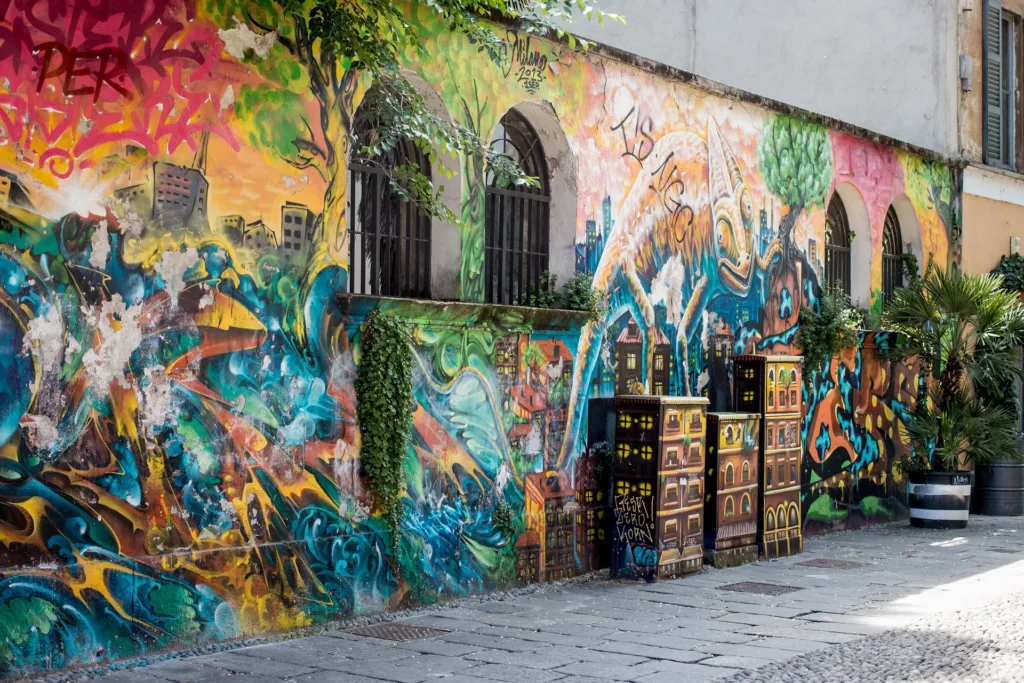
Image by Silke
If Milan conjures images of polished fashion runways and historic landmarks, then the artistic streets of Porta Ticinese will surprise and delight you. Known for its vibrant murals and edgy graffiti, this area reveals an entirely different side of Milan—a youthful, expressive, and raw creative pulse. Tucked away from the city’s mainstream attractions, it’s a hidden gem for solo travelers drawn to modern art and urban culture.
Here, the walls come alive with stories told through spray paint and stencils. Walking through Porta Ticinese feels like stepping into an open-air gallery, where every corner bursts with emotion, humor, and cultural commentary. Forget museums—this is art with no velvet ropes, and for those who love seeking out authenticity, it’s a must-visit.
What Makes It a Hidden Gem?
- Offbeat and Eclectic: Unlike Milan’s curated museums, Porta Ticinese’s walls are a canvas for self-expression, constantly evolving with new layers of creativity.
- Undiscovered by Crowds: While tourists flock to the Duomo and the Galleria, few venture here, giving it a more intimate and underground energy.
- A Window into Milan’s Youth Culture: This district vividly captures the spirit of the city’s younger generation—its dreams, frustrations, and wit—through striking visuals and bold messages.
- True Artistic Freedom: In contrast to Milan’s polished landmarks, the art here feels untamed, personal, and refreshingly real.
Why Solo Travelers Will Love It
- An Indie Adventure: Porta Ticinese lets solo travelers break away from the traditional tourist trails for a more offbeat experience.
- Perfect for Photography: Every street corner offers Instagram-worthy murals, making it a dream for photography enthusiasts.
- Freedom to Explore: Unwind and wander—following the art at your own pace is part of the fun.
- Meet the Locals: The casual vibe makes it easy to strike up conversations with Milan’s creative community, from street artists to cafe owners nearby.
Practical Information to Discover This Gem
Where Is It?
Porta Ticinese stretches near Navigli and runs along Corso di Porta Ticinese, a historic yet eclectic district.
How to Get There:
- By Metro: Take Line 2 (Green Line) to Porta Genova station, then walk 10 minutes into the area.
- By Tram: Trams 3 and 9 serve Porta Ticinese, with multiple stops in the neighborhood.
Costs: Completely free to explore, making it a budget-friendly activity for travelers.
Opening Hours: As an outdoor attraction, Porta Ticinese is always open. The art can be admired day or night, though the area is most vibrant during the afternoon or early evening.
Highlights You Can’t Miss
- Bold and Colorful Murals: Each wall tells a story, from poignant political statements to playful, surreal characters.
- The Graffiti Walk: Stroll along the main streets and side alleys to uncover hidden gems. The variety of artistic styles is astounding.
- The Piazza XXIV Maggio Atmosphere: Begin or end your visit at this hub, where locals gather around the nearby bars, shops, and cafes.
- The Contrast of Old and New: Where else can you see modern art painted on historic walls, blending Milan’s ancient fabric with its dynamic present?
Did You Know?
- Porta Ticinese has long been a gateway for transformation—historically part of Milan’s medieval walls, it’s now a district that channels the city’s evolving identity.
- The street art scene here grew out of the 1980s and 1990s urban art movement, and it has only gained momentum with new-generation artists.
- Some of the murals are created by internationally renowned street artists, while others remain anonymous, adding mystery to the collection.
Why It’s Perfect for Solo Travelers
- Raw Authenticity: It’s a break from Milan’s traditional image, offering solo travelers a modern-day adventure that feels organic and edgy.
- Time for Reflection: Wandering through the colorful streets lets you interpret the art in your own way, without crowds or interruptions.
- Cafes and Vibes: After exploring, grab a coffee or aperitivo at one of the many nearby cafes and soak in the unconventional energy of the area.
Porta Ticinese isn’t polished or picture-perfect, but that’s exactly what makes it one of Milan’s most fascinating hidden gems. For the solo traveler willing to venture beyond the usual attractions, this neighborhood offers more than vibrant walls—it’s a glimpse into Milan’s creative soul and a celebration of its ever-evolving identity.
Milan is a city that truly has it all: awe-inspiring landmarks, fascinating history, breathtaking art, and hidden corners waiting to be discovered. From the iconic Duomo di Milano to the serene elegance of Villa Necchi Campiglio, this vibrant city offers an unforgettable mix of experiences for solo travelers and beyond.
Whether you’re marveling at the Last Supper, exploring the lively Navigli canals, or uncovering the artistry of the Colonne di San Lorenzo, every place in Milan has a story to tell. It’s a journey through centuries of culture, creativity, and innovation that will captivate and inspire you.
So, lace up your walking shoes, grab your camera, and dive into all that Milan has to offer. From the famous landmarks to its most hidden gems, this city promises an adventure filled with discovery and wonder. And remember—each moment in Milan is yours to experience, one incredible attraction at a time.
Day Trips from Milan: The 10 Best Destinations Nearby
Milan may be Italy’s cosmopolitan heart, but its surroundings are filled with equally stunning destinations that promise adventure and charm. Whether you’re seeking tranquil lake views, medieval towns, culinary delights, or coastal escapes, Milan is perfectly located as a base for unforgettable day trips.
From the breathtaking shores of Lake Como and Lake Maggiore to the medieval charm of Bergamo and the colorful villages of Cinque Terre, these destinations highlight the very best of Northern Italy. Perfect for solo travelers, each location is accessible, rich in experiences, and filled with opportunities for exploration at your own pace.
Discover these 10 must-visit destinations that let you escape the city and experience the beauty, history, and culture just beyond Milan.
1. Lake Como
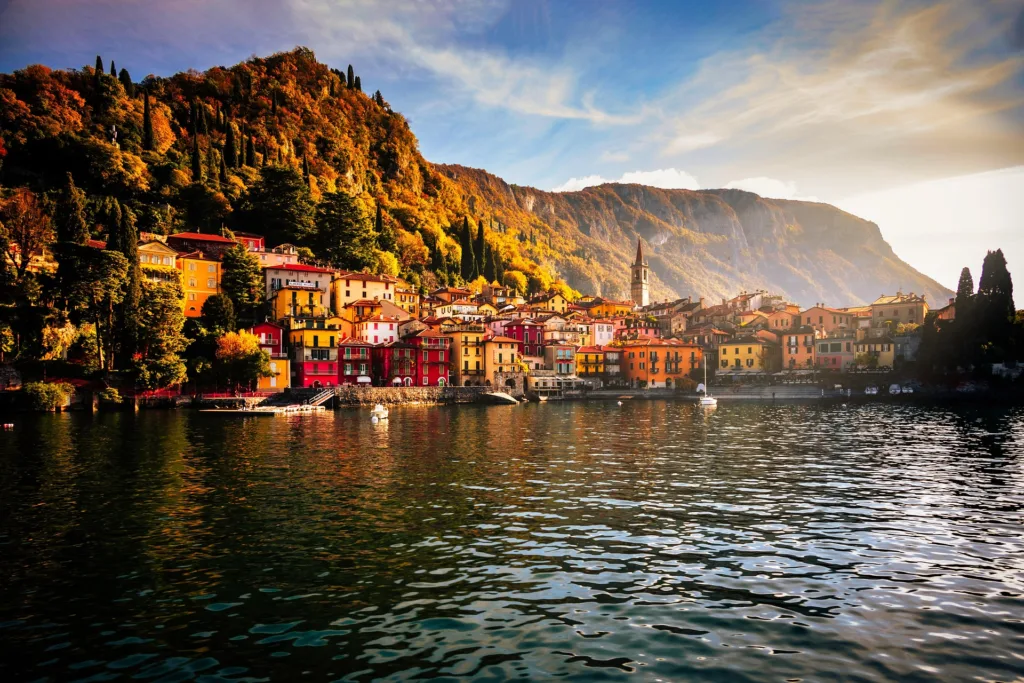
Image by G Poulsen
Why You Should Go: Lake Como is easily one of Italy’s most iconic and romantic destinations. Set against the dramatic Alps, its sparkling waters are bordered by luxurious villas, colorful villages, and lush gardens. For solo travelers, it’s the ultimate escape—offering serenity, stunning views, and endless opportunities to explore at your own pace. Whether you’re taking a relaxing boat ride or strolling the quaint streets of Bellagio or Varenna, every moment feels like stepping into a postcard.
Distance from Milan: 1–1.5 hours by train to Varenna or Como Town. From there, ferries make it effortless to hop between the lake’s enchanting towns.
Top Things to Do:
- Visit Varenna: Wander along its peaceful promenade, visit the stunning gardens at Villa Monastero, or take a short hike to Castello di Vezio.
- Bellagio’s Elegance: Known as the Pearl of the Lake, Bellagio offers cobblestone streets, boutique shops, and the serene Villa Melzi Gardens.
- Scenic Ferry Rides: Enjoy panoramic views of quaint villages and mountain peaks on a lake-crossing ferry.
- Hiking Trails: Explore the Greenway del Lago di Como, a scenic walking trail with unforgettable views.
Best Time to Visit: Spring (April–May) and Fall (September–October) are less crowded, with perfect weather for walking and boat rides, though summer’s vibrant energy has its own magic.
2. Bergamo
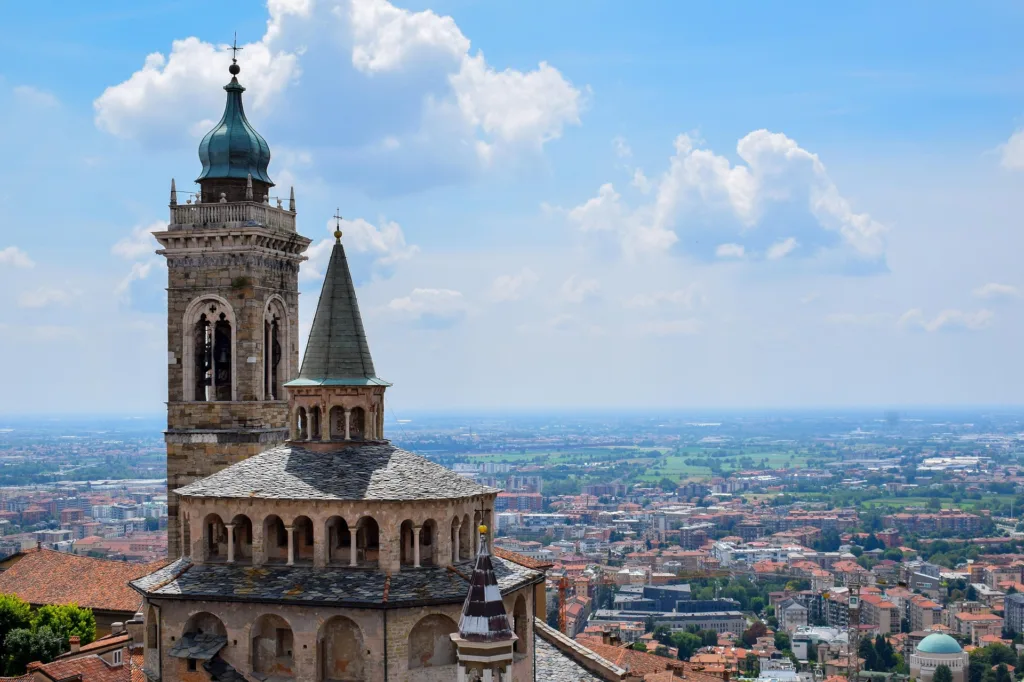
Image by Ben Kerckx
Why You Should Go: Bergamo is a city of contrasts, combining medieval history with modern Italian elegance. Its Città Alta (Upper Town), perched on a hill, feels like stepping back in time with its cobblestone streets, ancient walls, and stunning piazzas. Meanwhile, Città Bassa (Lower Town) brings modern cafes, vibrant squares, and the hum of local life. For solo travelers, it’s compact, walkable, and full of quiet corners to explore at your own pace.
Distance from Milan: 1 hour by train. Bergamo’s funicular connects Città Alta (the medieval town) with Città Bassa, making navigation simple.
Top Things to Do:
- Explore Piazza Vecchia: The heart of Città Alta, filled with architectural gems like the clock tower and library.
- Visit the Basilica di Santa Maria Maggiore: Renowned for its majestic frescoes and the intricacy of its interiors.
- Walk Along the Venetian Walls: These UNESCO World Heritage fortifications offer panoramic views of the surrounding countryside.
- Indulge in Local Cuisine: Try the regional specialty casoncelli, uniquely stuffed pasta with butter and sage sauce.
Best Time to Visit: Bergamo is enchanting year-round, but spring and summer are ideal for walking along the Venetian Walls and enjoying al fresco dining.
3. Lake Maggiore and Isola Bella
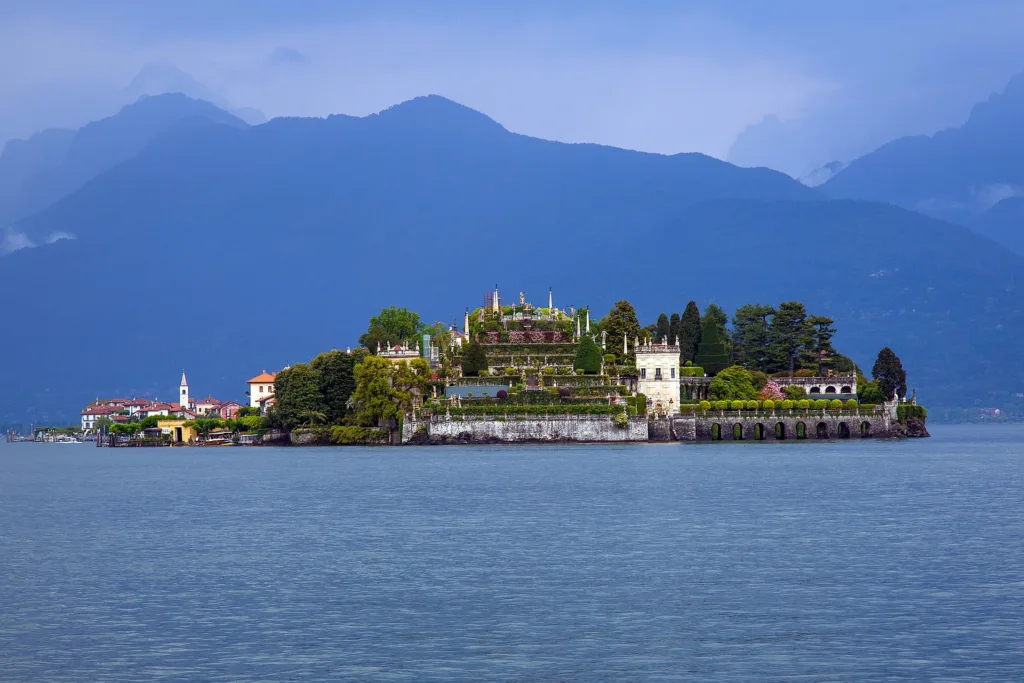
Image by Th G
Why You Should Go: Lake Maggiore is a serene escape framed by stunning Alpine scenery. While less famous than Lake Como, it’s equally picturesque, offering the added bonus of the Borromean Islands’ botanical beauty. For solo travelers, it’s a tranquil experience, perfect for peaceful exploration or snapping gorgeous photos. A visit to Isola Bella feels magical, as if stepping into an Italian fairytale.
Distance from Milan: 1.5 hours by train to Stresa, the main hub for exploring the Borromean Islands by ferry.
Top Things to Do:
- Isola Bella: Visit the opulent Palazzo Borromeo, surrounded by beautifully manicured gardens filled with sculptures and peacocks.
- Stroll Stresa’s Lakeside Promenade: Enjoy peaceful views or pop into one of its welcoming waterside cafes.
- Boat Tours: Hop between Borromean Islands, including the lush Isola Madre and the colorful fishing village of Isola dei Pescatori.
Best Time to Visit: Spring (April–May) is perfect for blooming gardens, while summer is great for lakeside relaxation and island-hopping experiences.
4. Verona
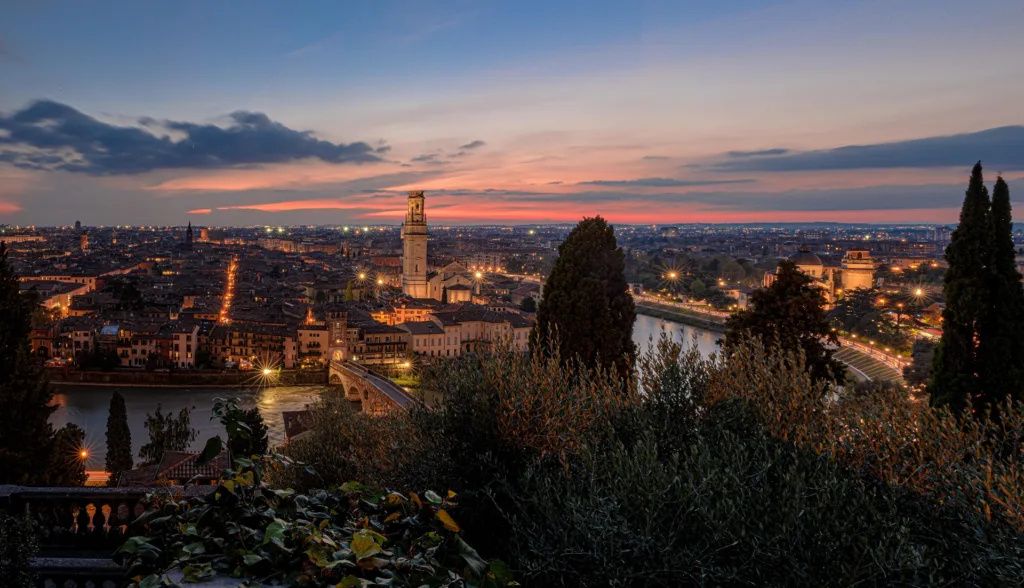
Image by max berliner
Why You Should Go: Few cities capture romance and history as perfectly as Verona. Famous as the setting for Shakespeare’s Romeo and Juliet, this UNESCO World Heritage city is rich with cobblestone streets, Roman ruins, and Renaissance charm. From its riverside views to its vibrant piazzas, exploring Verona feels like stepping into a living work of art. Solo travelers can take their time soaking up the city’s beauty, whether wandering Juliet’s fabled balcony or sitting in an open-air café at Piazza delle Erbe.
Distance from Milan:
1.5 hours by train. The compact historic center is just a short stroll from Verona Porta Nuova station.
Top Things to Do:
- Juliet’s Balcony: Visit Casa di Giulietta, a medieval house said to have inspired Shakespeare’s most famous love story.
- Arena di Verona: This Roman amphitheater is one of the city’s most impressive landmarks and still hosts operas and concerts.
- Piazza delle Erbe: Lined with colorful buildings and markets, it’s the perfect spot to immerse yourself in Verona’s vibrant daily life.
- Ponte Pietra: Walk across this historic stone bridge for stunning views of the Adige River.
Best Time to Visit: Spring and Fall are ideal for wandering the city streets and enjoying lighter crowds.
5. Parma

Image by DEZALB
Why You Should Go: Parma is Italy’s foodie capital, known worldwide for its beloved Parmesan cheese and Parma ham. But beyond the culinary delights, Parma boasts a wealth of cultural treasures—Renaissance architecture, grand piazzas, and a strong connection to the arts. For solo travelers, it’s a journey into indulgence, history, and authenticity.
Distance from Milan:
1.5 hours by train. The city’s compact layout makes it easy to explore on foot.
Top Things to Do:
- Savor Parmesan Cheese: Join a food tour or visit a Parmesan production dairy to learn about and taste this iconic ingredient.
- Visit Parma Cathedral: Admire the stunning frescoes and Romanesque architecture of this historic masterpiece.
- Teatro Farnese: Discover this intricate wooden theater, a true hidden gem within the Palazzo della Pilotta.
- Enjoy Parma Ham: Head to a trattoria to enjoy a plate of authentic prosciutto di Parma paired with local wines.
Best Time to Visit: Year-round, but autumn is especially delightful with food festivals celebrating Parmesan and Parma ham.
6. Turin (Torino)
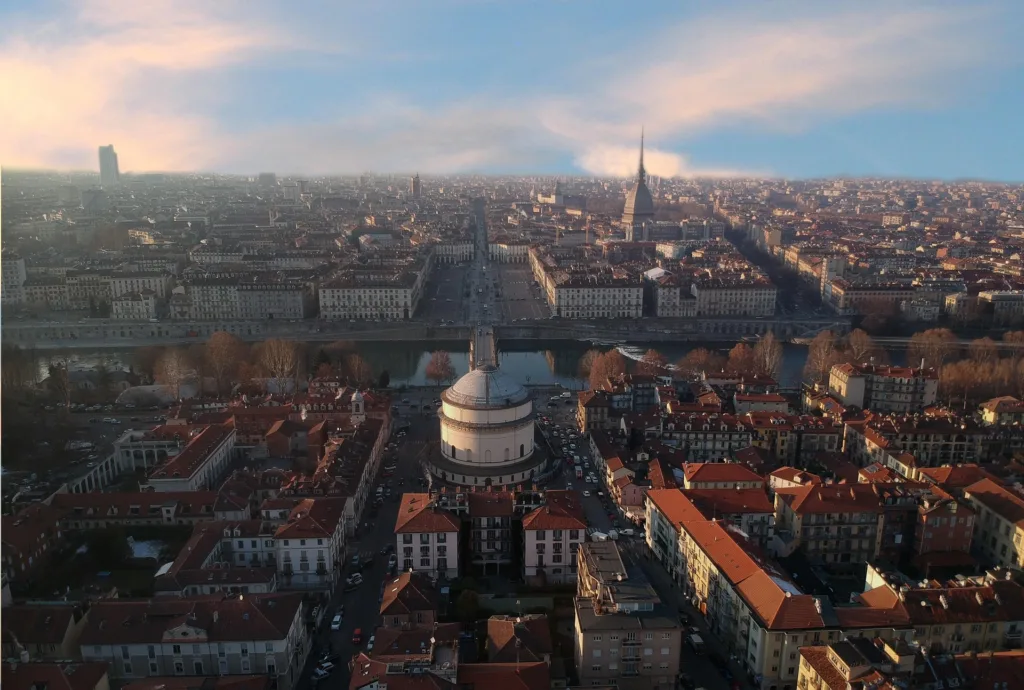
Image by u_3rcax7x0xv
Why You Should Go: As Italy’s first capital city, Turin is an elegant blend of Baroque architecture, fascinating museums, and enticing food culture. Known for its regal squares, chocolate specialties, and vibrant coffeehouse scene, Turin offers refinement with a relaxed pace. Solo travelers will appreciate its walkable historic center and mix of history, art, and unmistakable Piedmont charm.
Distance from Milan: 1 hour by high-speed train. The main attractions are within walking distance from Torino Porta Nuova station.
Top Things to Do:
- Mole Antonelliana: Turin’s iconic tower houses the fascinating National Cinema Museum and offers breathtaking views from its panoramic terrace.
- Egyptian Museum: Explore one of the largest and most important collections of ancient Egyptian artifacts outside of Cairo.
- Piazza San Carlo: Nicknamed “Turin’s living room,” this grand square is perfect for people-watching over a rich hot chocolate or a cappuccino at a historic café.
- Try Bicerin: Enjoy this decadent chocolate and coffee drink, a Turin specialty that’s perfect for solo indulgence.
Best Time to Visit: Spring or Fall to enjoy comfortable weather and walking tours, though winter adds a magical touch with hot chocolate and cozy cafes.
7. Cinque Terre
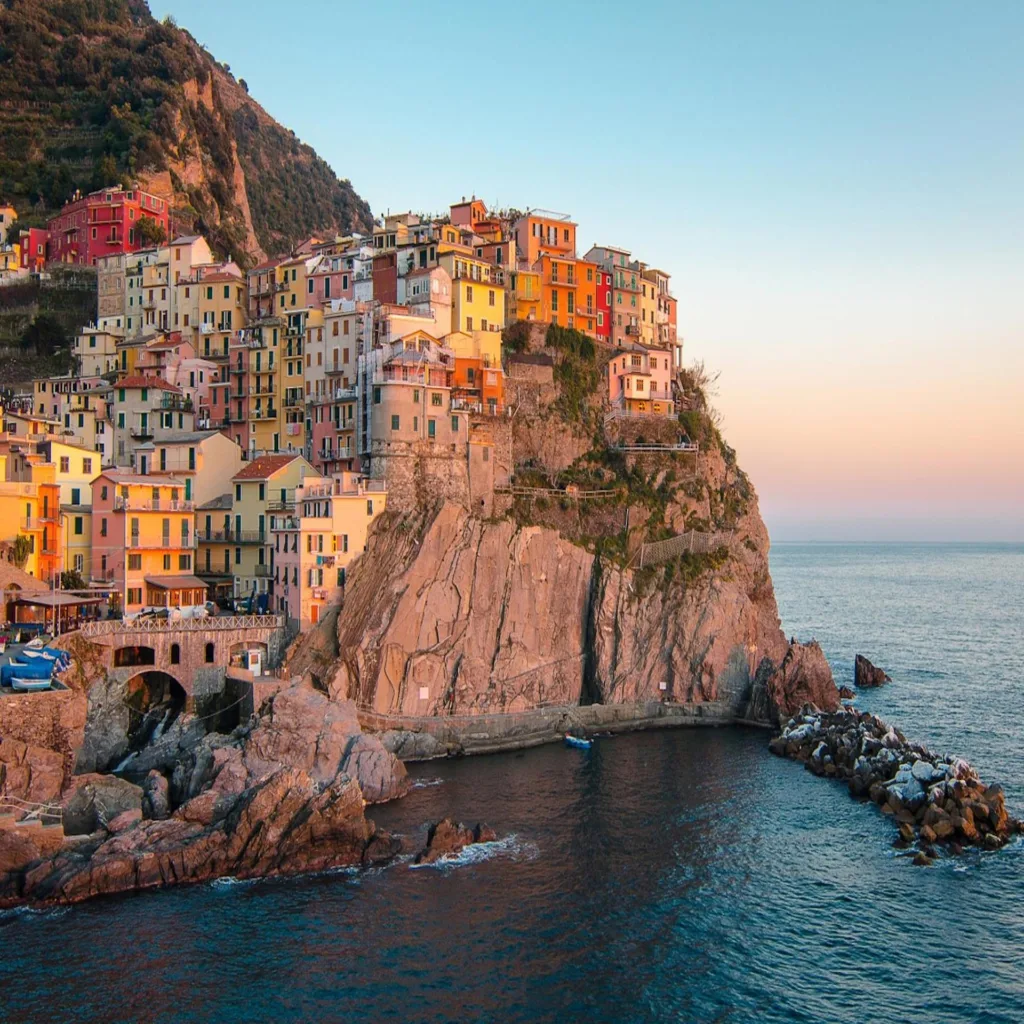
Why You Should Go: Cinque Terre is like stepping into a postcard—five colorful villages clinging to the cliffs overlooking the sparkling Ligurian Sea. With scenic hiking trails, fresh seafood, and stunning coastal views, this UNESCO World Heritage Site is perfect for adventurous solo travelers. The charm of Monterosso al Mare, Vernazza, Corniglia, Manarola, and Riomaggiore is undeniable, making it one of Italy’s most beautiful day trips.
Distance from Milan: 2.5–3 hours by train to Monterosso or Riomaggiore. Trains connect the villages, making them easy to explore in a single day.
Top Things to Do:
- Hike the Trails: The Blue Trail (Sentiero Azzurro) connects the villages, offering breathtaking views of the coastline.
- Visit Vernazza: Known for its picturesque harbor, it’s regarded as one of the most stunning villages in Cinque Terre.
- Enjoy Seafood in Manarola: Sample fresh seafood dishes like spaghetti alle vongole while admiring the sea.
- Relax in Monterosso: The only village with a beach, making it perfect for a calming solo escape.
Best Time to Visit: Spring (April–May) and Fall (September–October) are ideal for pleasant weather and manageable crowds.
8. Modena
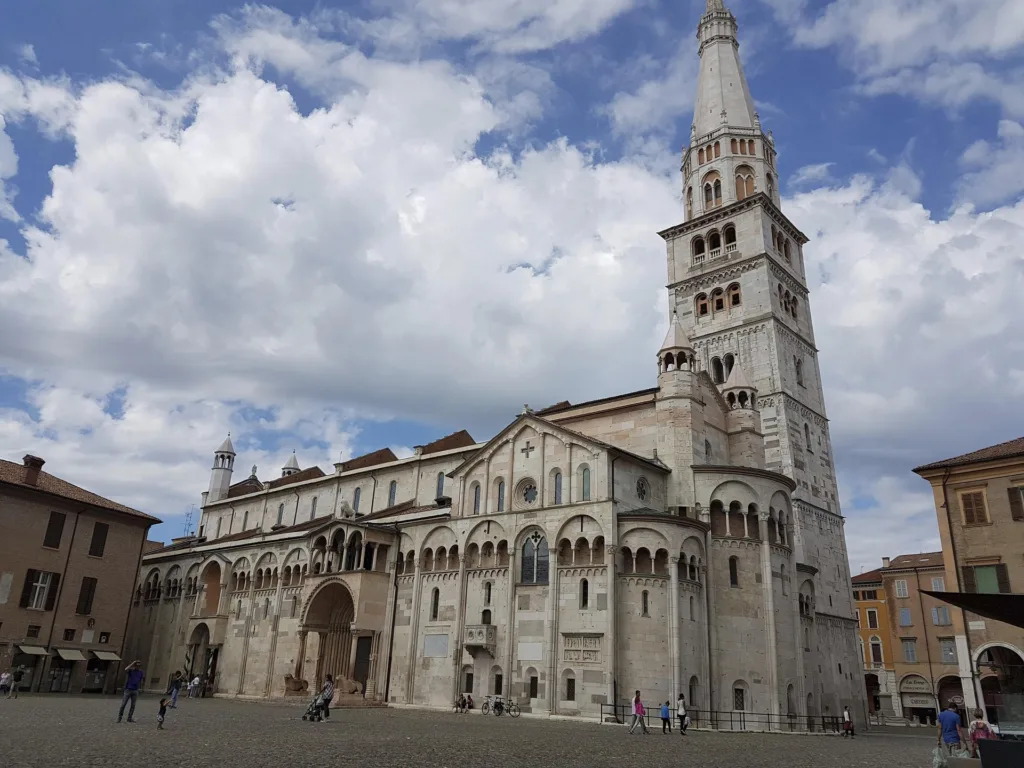
Why You Should Go: Modena is a captivating destination for car enthusiasts, food lovers, and history buffs alike. Famed for its traditional balsamic vinegar and connections to luxury car brands like Ferrari, this small city offers an abundance of Italian charm. For solo travelers, it’s both walkable and packed with unique experiences.
Distance from Milan: 1.5–2 hours by train. The historic center is easily accessible from Modena station.
Top Things to Do:
- Balsamic Vinegar Tasting: Visit a traditional vinegar producer to learn about and sample Modena’s prized Aceto Balsamico Tradizionale.
- Enzo Ferrari Museum: Celebrate Modena’s automotive legacy with Ferrari’s history and exhibits.
- Piazza Grande: Stroll through this lively square, surrounded by the Modena Cathedral and its UNESCO-listed Ghirlandina Tower.
- Indulge in Modenese Cuisine: Don’t miss a plate of tortellini en brodo or gnocco fritto at a local trattoria.
Best Time to Visit: Year-round, though Fall is especially atmospheric with harvest flavors and beautiful seasonal colors.
9. Sirmione (Lake Garda)
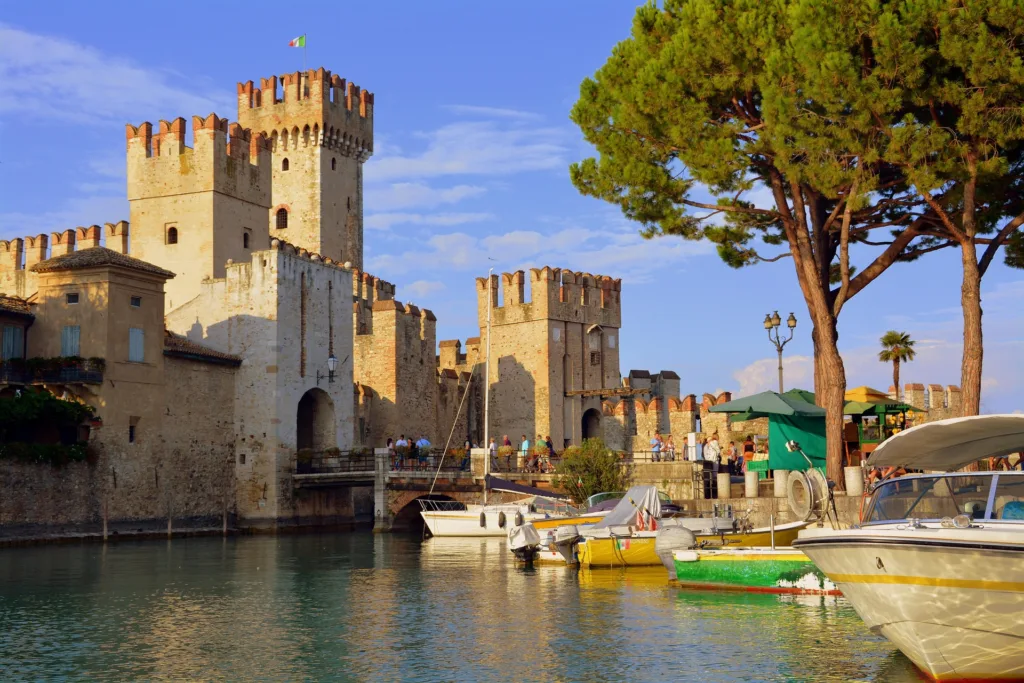
Why You Should Go: Sirmione, situated on a narrow peninsula jutting into Lake Garda, is a dreamy lakeside escape with turquoise waters, historic castles, and relaxing thermal spas. This chic and charming town offers a refreshing mix of history, luxury, and natural beauty, making it ideal for a solo day trip.
Distance from Milan: 1.5–2 hours by train and bus. Travel via Desenzano del Garda, then take a short bus ride to Sirmione.
Top Things to Do:
- Scaligero Castle: Wander through this spectacular 13th-century fortress with breathtaking views of Lake Garda.
- Grottoes of Catullus: Explore the ruins of a vast Roman villa perched on the peninsula’s tip.
- Thermal Baths: Relax at one of Sirmione’s famed thermal spas, such as Aquaria Thermal Spa, for a rejuvenating experience.
- Lakeside Promenade: Stroll along the waterfront or find a quiet spot to enjoy the serene lake views.
Best Time to Visit: Spring and Summer bring vibrant energy, while Fall offers a more tranquil experience by the lake.
10. Valcamonica (Rock Engravings)

By Luca Giarelli – Own work, CC BY-SA 3.0, Link
Why You Should Go: Home to one of the largest collections of prehistoric rock carvings in the world, Valcamonica is a UNESCO World Heritage Site perfect for history lovers and nature enthusiasts. Nestled in an Alpine valley, it marks a unique fusion of art, archaeology, and stunning mountain landscapes. Solo travelers will enjoy the peaceful hiking trails and one-of-a-kind glimpse into ancient human expression.
Distance from Milan: 2–2.5 hours by train and bus to Capo di Ponte, where the main rock carving sites are located.
Top Things to Do:
- Explore the National Park of Rock Engravings: Wander among thousands of prehistoric carvings that depict hunting, rituals, and daily life.
- Visit Cemmo’s Rock Sites: Cemmo is one of the richest areas for carvings and artifacts, dating back 8,000 years.
- Nature Trails: Enjoy the surrounding Alpine beauty with short hikes around Capo di Ponte and the valley.
- Cultural Museums: Learn about the region’s history and people through interactive exhibits at local museums.
Best Time to Visit: Spring and summer offer the best weather for hiking and exploring the open-air rock carvings.
Conclusion
Milan isn’t just an incredible city on its own—it’s also the gateway to some of Italy’s most amazing destinations. Whether you’re wandering the cobblestone streets of Verona, savoring Parmesan cheese in Parma, or relaxing by the sparkling waters of Lake Garda, these day trips offer the perfect balance of city and countryside.
For solo travelers, these escapes provide a mix of history, nature, and cultural experiences that are easy to enjoy on your own. With comfortable train connections and a range of unique spots to explore, you can craft a day trip that’s as relaxed or adventurous as you’d like.
Which destination will you explore first? Whether it’s a charming lakeside town or a historic cityscape, the beauty of your Milan journey is just a short trip away.
FAQs About Traveling to Milan
1. Is Milan worth visiting for a solo traveler?
Absolutely! Milan is a fantastic destination for solo travelers. It’s a safe, walkable city where you can explore iconic landmarks, immerse yourself in art and history, and enjoy world-class food at your own pace. With its cosmopolitan vibe, Milan offers a blend of vibrant energy and quieter escapes, making it easy for solo travelers to feel comfortable and entertained. Whether you’re shopping in the Galleria Vittorio Emanuele II, enjoying aperitivo in Navigli, or admiring the artistry of Da Vinci’s The Last Supper, Milan provides countless opportunities for memorable solo adventures.
2. What are the must-see attractions in Milan?
Milan is brimming with must-see landmarks that reflect its rich history and culture. Some unmissable sites include:
- Duomo di Milano: The Gothic cathedral that’s the heart of the city. Don’t miss the panoramic views from its rooftop.
- Galleria Vittorio Emanuele II: A breathtaking 19th-century shopping arcade with stunning architecture.
- The Last Supper: Leonardo da Vinci’s masterpiece housed in Santa Maria delle Grazie.
- Navigli Canals: A charming area perfect for evening strolls and aperitivo.
- Sforza Castle: A historic fortress filled with museums and surrounded by Parco Sempione.
These spots are perfect for getting a sense of Milan’s unique blend of art, history, and modern flair.
3. How many days do I need to explore Milan?
For a full experience, 3 days is ideal to explore Milan’s top attractions and enjoy its vibrant neighborhoods at a relaxed pace.
- Day 1: Visit the Duomo, Galleria Vittorio Emanuele II, and the Last Supper, followed by aperitivo in Navigli.
- Day 2: Explore Sforza Castle, Pinacoteca di Brera, and Parco Sempione.
- Day 3: Take a deep dive into Milan’s fashion and design scene with a stroll along Via Montenapoleone or a visit to the Museo del Novecento.
If you’re short on time, Milan is also doable in 1–2 days by prioritizing the Duomo, The Last Supper, and Navigli.
4. Is it expensive to visit Milan?
Milan is one of Italy’s pricier cities, but it’s still possible to visit on a budget.
- Accommodation: Budget hostels and hotels start at €30 per night, while mid-range hotels range from €80–€150.
- Food: Affordable trattorias serve excellent meals for around €15–€25. Street food, like panzerotti from Luini, is even cheaper.
- Transport: The public transport system is budget-friendly, with single tickets costing €2 and day passes around €7.
Splurging on luxury dining and high-end fashion can escalate expenses, but Milan offers options for all budget levels.
5. What are the best day trips from Milan?
Milan’s location makes it a gateway to stunning day trips, with plenty of options just a short train ride away:
- Lake Como: Explore Bellagio and Varenna for lakeside charm.
- Bergamo: Visit the medieval town of Città Alta.
- Verona: Discover the romantic city of Romeo and Juliet.
- Sirmione (Lake Garda): Relax by the lake and visit Scaligero Castle.
- Modena: Indulge in balsamic vinegar tastings and explore its cultural heritage.
Each destination offers a unique escape from Milan’s urban buzz, with plenty for solo travelers to enjoy.
6. How do I buy tickets for The Last Supper?
Getting tickets to see Leonardo da Vinci’s The Last Supper requires planning ahead, as tickets sell out quickly due to limited visitor slots. Here’s how to book:
- Official Website: Purchase directly from the official ticketing site for Santa Maria delle Grazie. Tickets cost around €15 and include a reserved time slot.
- Guided Tours: Many tour companies bundle Last Supper tickets with guided city tours, which is a good option if official tickets are sold out.
- Tips for Availability: Book at least 2–3 months in advance, especially during the peak season. If you’re visiting spontaneously, check for last-minute cancellations.
Advanced booking ensures you won’t miss this world-famous masterpiece!
7. How can I avoid crowds when visiting Milan?
Avoiding crowds in Milan is all about timing and planning:
- Visit in the Off-Season: Travel in spring (April–May) or fall (September–October) when the weather is pleasant, but crowds are thinner.
- Early and Late Visits: Arrive early in the morning to iconic spots like the Duomo and Galleria Vittorio Emanuele II, or visit during the last hour before closing.
- Pre-Book Tickets: Pre-purchasing tickets for attractions like The Last Supper and Duomo rooftops helps you skip the lines.
- Explore Hidden Gems: Venture away from tourist zones to quieter areas like Brera, Isola, or Porta Ticinese for a more local feel.
Planning visits during weekdays instead of weekends also makes a massive difference in crowd levels.
8. Are there free attractions or things to do in Milan?
Yes, Milan offers plenty of free things to do for travelers looking to explore on a budget:
- Stroll Through Parco Sempione: This spacious park behind Sforza Castle is perfect for unwinding or enjoying a peaceful walk.
- Visit Piazza del Duomo: While the Duomo’s interior and rooftop require tickets, you can admire its Gothic exterior and lively square for free.
- Explore Brera District: Wander cobblestone streets, browse galleries’ exteriors, or relax in charming cafes.
- First Sundays: Many museums and cultural landmarks offer free entry on the first Sunday of every month, including civic museums like the Museo del Novecento.
- Discover Street Art: Head to Porta Ticinese or Navigli to find colorful, artistic murals.
9. What’s unique about Milan compared to other Italian cities?
Milan sets itself apart with its sophistication, modernity, and artistic innovation, making it distinct from Italy’s more historic or traditional cities like Rome or Florence.
- Fashion Forward: As the fashion capital of Italy, Milan hosts Milan Fashion Week and boasts the Quadrilatero d’Oro, filled with luxury boutiques.
- Art & Architecture: The city is home to unique Gothic landmarks like the Duomo, modern spaces like the Bosco Verticale, and stunning art such as da Vinci’s The Last Supper.
- Urban Energy: While many Italian cities feel steeped in the past, Milan has a forward-thinking vibe, blending history with design and technology.
Its cosmopolitan energy, coupled with a rich cultural heritage, makes it a dynamic destination that’s both traditional and cutting-edge.
10. Where can I go shopping in Milan as a solo traveler?
Milan is a haven for shopping, offering everything from luxury goods to vintage treasures:
- Quadrilatero d’Oro (Fashion District): Explore high-end boutiques like Prada, Gucci, and Versace along Via Montenapoleone and Via della Spiga.
- Galleria Vittorio Emanuele II: This stunning arcade is perfect for window shopping luxury brands and enjoying the scenery.
- Brera District: Known for its artistic vibe, Brera has boutique shops, artisanal jewelry, and unique finds.
- Corso Buenos Aires: A budget-friendly shopping street filled with international brands and smaller stores.
- Vintage Markets: Check out flea markets like Fiera di Sinigaglia for vintage clothing, antiques, and one-of-a-kind pieces.
Whether you’re shopping for designer fashion or quirky souvenirs, Milan’s shopping scene has something for everyone.
11. Can I walk to most of Milan’s attractions?
Yes, Milan is a very walkable city, especially within the historic center where many major attractions are grouped together.
- Duomo di Milano, Galleria Vittorio Emanuele II, and Sforza Castleare all within a short walking distance.
- Strolling through districts like Brera or Navigli is the best way to absorb their charm, as these areas are filled with narrow streets, cozy cafes, and local shops.
For anything farther out—like The Last Supper or modern skyscrapers in Porta Nuova—you can easily combine walking with public transport for seamless exploration.
12. What’s the best way to spend 24 hours in Milan?
If you have just 24 hours in Milan, here’s a perfect one-day itinerary to see the highlights:
- Morning: Start your day at the Duomo di Milano and explore its stunning interior. Climb to the rooftop for panoramic views of the city.
- Midday: Grab lunch in the Galleria Vittorio Emanuele II and take a short walk to see Leonardo da Vinci’s The Last Supper at Santa Maria delle Grazie.
- Afternoon: Visit Sforza Castle and relax in Parco Sempione behind it for some greenery.
- Evening: Head to Navigli Canals for Milan’s iconic aperitivo scene and a laid-back stroll along the waterways.
This itinerary gives you a mix of Milan’s history, art, and vibrant contemporary culture.
13. Is Milan child-friendly for family travel?
Yes, Milan is surprisingly child-friendly with plenty of activities and attractions for families:
- Parks and Green Spaces: Parco Sempione and Giardini Pubblici Indro Montanelli are perfect for kids to play and enjoy nature while parents relax.
- Interactive Museums: The Leonardo da Vinci Museum of Science and Technology offers hands-on exhibits that kids will love.
- Trams and Funiculars: Children enjoy riding the historic trams, offering a unique and fun way to explore the city.
- Sforza Castle: Older kids will enjoy the castle’s towers, dungeons, and art exhibits, while the park behind it is perfect for younger ones.
With a mix of educational spots and chances to burn off energy, Milan makes family visits easy and memorable.
14. Do I have to book attractions in advance in Milan?
It’s highly recommended to book tickets in advance for Milan’s most popular attractions, especially during peak travel seasons.
- The Last Supper: This is a must, as spaces are incredibly limited—book 2–3 months ahead.
- Duomo Rooftop: While you can buy tickets on-site, online booking helps you skip long lines.
- Museums and Theaters: For places like the Museo del Novecento or Teatro alla Scala, advance reservations guarantee entry and save time.
Some attractions offer flexible passes (like fast-track tickets), making them ideal for travelers short on time.
15. Can I visit Milan’s attractions on a tight schedule?
Yes, Milan can absolutely be enjoyed on a tight schedule, thanks to its compact city center and efficient public transportation.
- Focus on key landmarks: Start with the Duomo, The Last Supper, Sforza Castle, and Galleria Vittorio Emanuele II.
- Use public transport: The metro and trams quickly connect major attractions.
- Book tickets in advance: This ensures you make the most of your visit without wasting time in lines.
Even with just half a day or one day, you can experience Milan’s unique blend of history, art, and vibrant city life.











